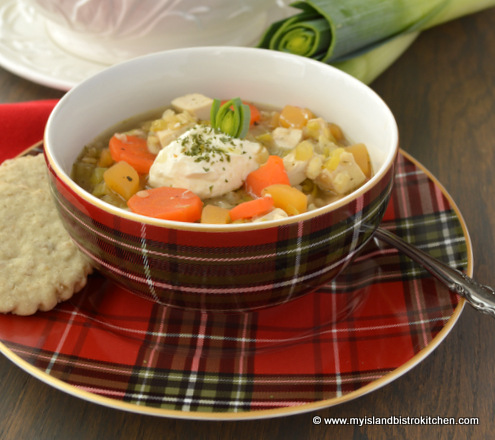
Cock-A-Leekie soup was on the menu during my first cruise in 1991 and I have loved this simple fare ever since. Continue reading Cock-A-Leekie Soup

Cock-A-Leekie soup was on the menu during my first cruise in 1991 and I have loved this simple fare ever since. Continue reading Cock-A-Leekie Soup
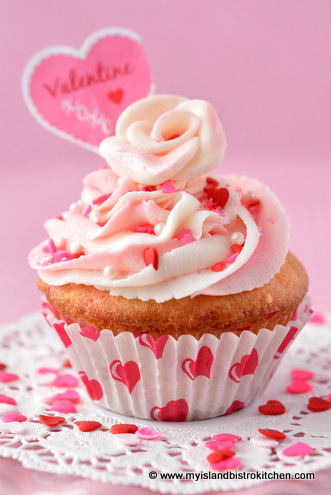
Today marks my 4th Blogiversary and I’m celebrating with my newly-developed recipe for Dreamy Hawaiian Cupcakes! These are perfect for any event, any time of the year but, with their pink swirl centers and mile high frosting, I think they would be very suitable for Valentines Day. So, they’re doing double duty as they celebrate my 4th Blogiversary and act as a catalyst for Valentine’s baking.

These cupcakes deliver a flavor punch with coconut milk, amaretto, shredded coconut, and maraschino cherries. That’s a flavor combo that’s hard to beat!

In addition to the wonderful flavor, the coconut milk makes these cupcakes lovely and moist. They also have a fine tender crumb which makes them very velvety when you sink your teeth into them.

Here are my tips and recommendations for making cupcakes:
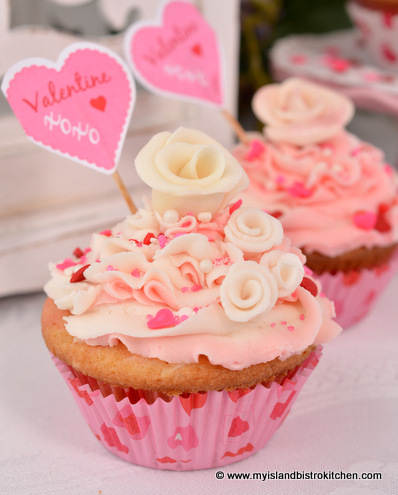
The frosting consists of two flavors to complement the cupcake flavor – coconut and cherry. Combined, these two recipes will give you ample to frost 12 cupcakes with mile high swirled frosting as shown in the photos. If, however, that’s just a tad too much frosting for your taste, simply make just one of the frosting recipes.
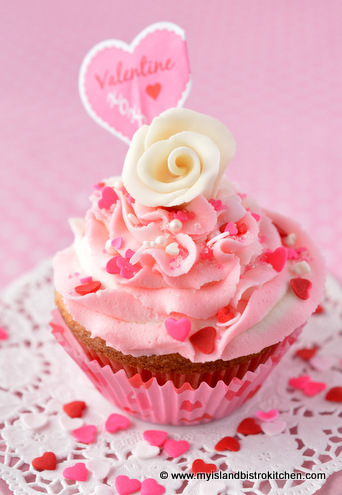
I used Wilton decorating tip 2D for the swirl frosting and the two colors were achieved by filling one side of the decorating bag with white frosting and the other side with the cherry frosting.
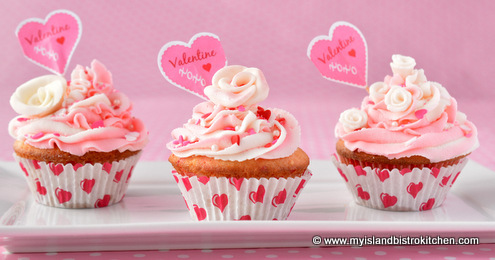
Ingredients:
1½ cups all-purpose flour
1½ tsp baking powder
¼ tsp baking soda
½ tsp salt
½ cup butter, room temperature
1 cup granulated sugar
2 extra-large eggs
1 tsp vanilla
1 tbsp Amaretto
½ cup coconut milk
1/3 cup shredded coconut
¼ cup chopped maraschino cherries, well drained and patted dry
Pink food coloring
Method:
Preheat oven to 350°. Grease 12 muffin cups or, alternatively, line each cup with paper cupcake liners.
In medium-sized bowl, combine four dry ingredients. Set aside.
Fit mixer with paddle attachment. Cream butter and sugar until fluffy. Add the eggs, one at a time, beating well after each addition. Add the vanilla and Amaretto.
Add the dry ingredients in three parts alternately with the coconut milk, starting and ending with the dry ingredients.
Remove ½ cup of the batter and add the food coloring to it, just enough to tint the batter pink.
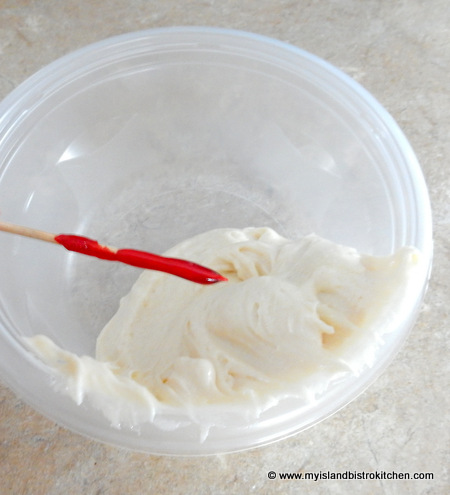
Add the coconut and chopped cherries to the white batter.
Fill each muffin cup about 1/3 full with the white coconut batter. Divide the ½ cup of pink batter between the 12 cupcakes.
Divide the remaining white batter evenly between the 12 cupcakes.Use the tip of a knife to gently swirl the pink batter into the white in each cupcake.
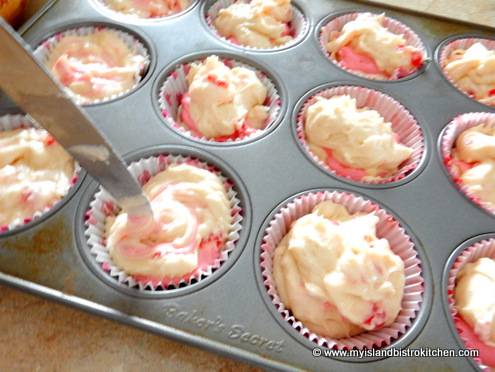
Bake in center of oven for 15-19 minutes or until cupcakes spring back to a light touch or a cake tester inserted into center of a cupcake comes out clean. Cool cupcakes in pan for 3-4 minutes then carefully transfer them to wire rack to cool completely.

Frost and decorate cupcakes as desired. The two frosting recipes provided with this recipe will, combined, easily frost the 12 cupcakes with the amount of swirled frosting shown in the photographs that accompany the cupcake recipe. If less frosting is desired, make only one of the recipes.

¼ cup butter
¼ cup shortening
1 tbsp coconut milk
¼ tsp almond flavouring
Apx. 2 cups confectioners (powdered) sugar, sifted
Sprinkle of salt (optional)
Beat butter and shortening together. Add coconut milk and almond flavouring. Blend in enough sifted confectioners sugar for desired spreading consistency.
Cherry Frosting
¼ cup butter
¼ cup shortening
1½ tbsp cherry juice
¼ tsp almond flavouring
Apx. 2 cups confectioners (powdered) sugar, sifted
Sprinkle of salt (optional)
Beat butter and shortening together. Add cherry juice and almond flavouring. Blend in enough confectioners sugar for desired spreading consistency.
To achieve dual-colored swirl frosting, fit cake decorating bag with Wilton 2D decorating tip. Fill one side of decorating bag with the white frosting and the other half with the pink frosting. Pipe onto cupcake in swirl motion.
—————————————————————————-
Thank you for visiting “the Bistro” today. If you enjoyed this posting and recipe, please share it on your social media websites.
Connect with “the Bistro” through the following social media:
Join My Island Bistro Kitchen on Facebook
Follow “the Bistro’s” tweets on Twitter
Follow “the Bistro” on Pinterest
Follow “the Bistro” on Instagram
——————————————————————————
Rich and decadent cupcakes packed full of coconut flavour and covered in mile-high coconut and cherry frosting
Ingredients
Instructions
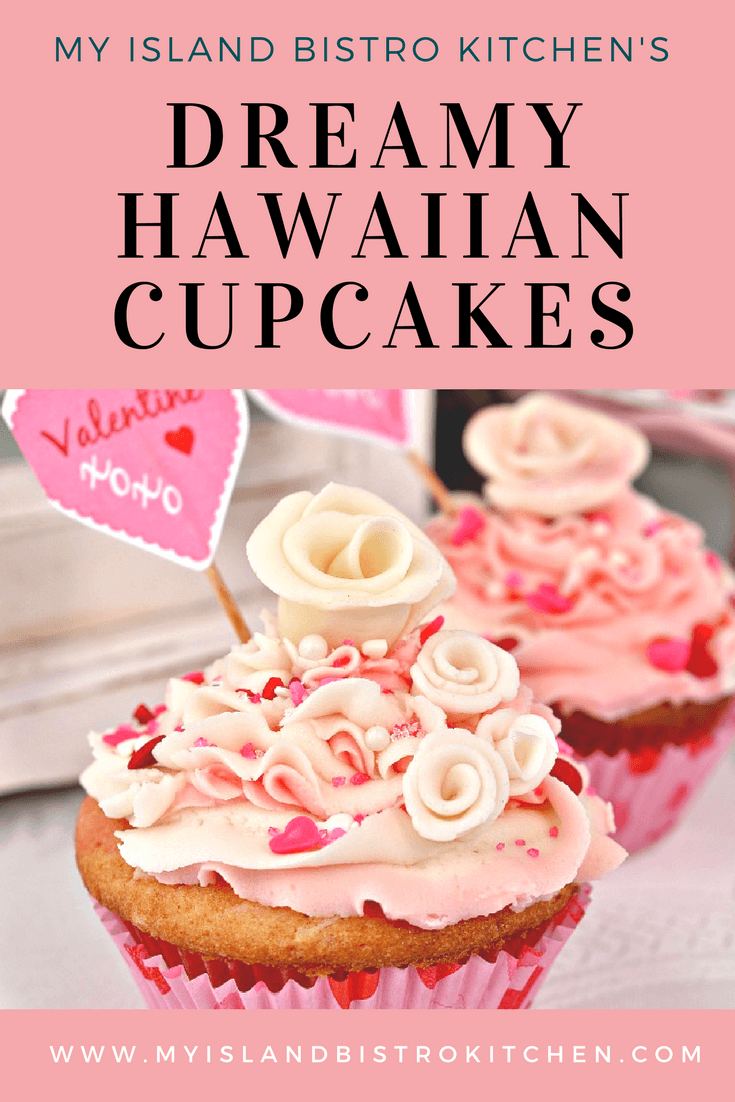
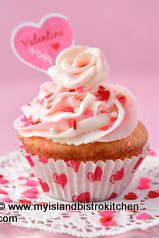

There are so many ways to make rice pudding. Some use the stove-top method, others (like me) use the oven. Some bake the rice pudding directly in the oven but I prefer the hot water bath method for reasons explained below.
For rice pudding, I prefer a short grain rice such as Arborio which is what I have used in this pudding. Arborio rice (often used in risotto) is named after the Italian town where it is grown. What makes it my preference for rice pudding is that, when cooked, it has lovely round pearl-like grains that hold their shape and don’t turn to “mush”. This rice also has a high starch level and that helps to self-thicken the pudding as it bakes and also contributes to its creamy texture.

This pudding is true comfort food. The addition of coconut milk gives the pudding a subtle hint of coconut but not so strong that it detracts from the basic flavour we expect to find in an old-fashioned rice pudding. I think the texture of the coconut milk also helps to keep the custard creamy.
I have used a maple syrup that was infused with cinnamon, nutmeg, and cloves. This does add a bit of discrete flavor to the pudding but, certainly, plain maple syrup would work just fine. I have added a blend of three spices – cardamon, nutmeg, and cinnamon – but again, not in large quantities because I don’t want the pudding to be overly spiced. I just want it to be delicately flavored.
Raisins, a traditional addition to rice puddings, do need to be “plumped” before adding them to the pudding as, otherwise, they don’t become very soft in the custard. It’s not very pleasing to the palette to bite into hard, dry raisins amidst a soft creamy custard. For this recipe, I have soaked the 1/3 cup of raisins in about 1 tablespoon of Amaretto by placing these two ingredients in a small covered dish for at least 45 minutes. Shaking the dish periodically helps to ensure that all raisins are coated with the liqueur. In fact, you could leave them soaking for a couple of hours (the raisins will just be extra happy if you do so!).
Rice pudding custard is actually quite delicate and, for greatest success, it is best if the egg proteins are protected from direct hot heat and from fast baking. Because the pudding is made with an egg-milk custard, it is therefore, in my opinion, best if it is baked slowly in a hot water bath. This is simply a method of baking whereby the pudding dish(es) are placed inside a larger pan into which hot water is poured up to about half way on the pudding dishes or even up to the level of the custard in the ramekins. However, the water should not be so deep that the pudding dishes start to float. They need to sit stable in the water as the pudding bakes.
The benefits of baking this pudding in a hot water bath are several. First, the hot water adds steam and moisture to the oven which will prevent the puddings from drying out and cracking on the top as they bake. Second, any custard mixture of milk and eggs has the potential to curdle – that’s when the milk-egg mixture separates from the solids (in this case, the rice and raisins). Because it is a slower method of baking and the hot water provides an even heat source, the hot water bath method helps to prevent the risk of curdled custard. The hot water also helps the custard to bake evenly, both its outside edges as well as its center. Without the hot water baking method, the custard could bake quicker on the outside edges of the pudding than in the center and part of the pudding would be dried out. Lastly, the slow baking combined with an oven of moist heat will help to keep the pudding creamy in texture as opposed to “rubbery”.
I place the 9″x13″x2″ pan with the ramekins in it on the oven shelf and just ever-so-slightly pull the shelf out, just enough that I can safely pour the hot water into the larger baking pan without getting a burn. I find this is a safer method than filling the pan with the hot water and transporting it to the oven. The water needs to be kept at the same level during the baking process so, since it naturally evaporates, you may need to add more hot water as the pudding bakes.
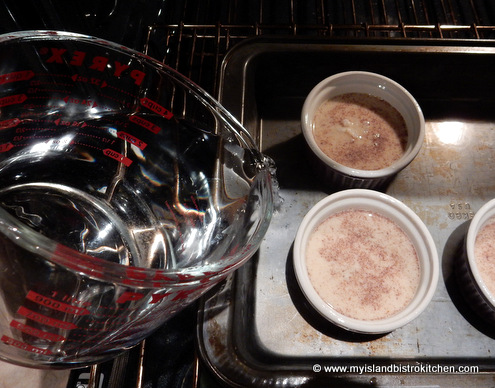
Bake the puddings for approximately 1 hour or until pudding top edges are set, centers are still a little “jiggly”, and the puddings are golden-colored. A knife inserted in or near the centre of the pudding should come out clean if the pudding is done. Don’t overbake the pudding as it will dry out and be less creamy. Remove ramekins from water bath and let them stand on a wire rack to set for approximately 10 minutes before serving.
Adding toasted coconut to the top of this pudding is optional but the crunchiness and flavour are an added touch. Toasting coconut is simple. The coconut gets spread thinly on a baking sheet and baked in a 350° F oven for about 8-9 minutes. It is important to watch that the coconut does not burn and it should be turned once or twice during the toasting process to ensure even color.

Ingredients:
1¼ cups cooked Arborio rice
1/3 cup raisins, soaked in 1 tbsp Amaretto
½ cup coconut milk
¾ cup whole milk
1 extra-large egg, lightly beaten
2 tbsp granulated sugar
2 tbsp maple syrup
¼ tsp salt
½ tsp vanilla
1/8 tsp cardamom
1/8 tsp nutmeg
¼ tsp cinnamon
¼ cup shredded coconut (sweetened or unsweetened), toasted (optional)
Method:
In small covered dish, soak raisins in Amaretto for at least 45 minutes to plump them, shaking or stirring occasionally to ensure all raisins are coated with the liqueur.
Cook rice according to package directions.
Preheat oven to 325°F. Grease 6 – ¾-cup size ramekin dishes.
In large bowl, whisk together the coconut and whole milk, egg, sugar, maple syrup, salt, vanilla, and spices. Add rice and raisins and stir gently. Divide mixture between 6 prepared ramekins and place in 9”x13”x2” pan. Pour hot water into pan up to half-way on the sides of the ramekins or even up to about the level of the custard in the dishes. However, make sure the ramekins are not floating in the water.
Bake for approximately 1 hour or until pudding top edges are set, centers are still a little “jiggly” and puddings are golden-colored. A knife inserted in or near the centre of the pudding should come out clean if the pudding is done. Remove ramekins from water bath and let stand on wire rack to set for approximately 10 minutes before serving. To serve, top each with toasted coconut, if desired.
[To toast coconut: Spread coconut on baking sheet and bake in 350° F oven for 8-9 minutes, stirring once or twice, until coconut is lightly tanned in color.]
Yield: 6 servings.
—————————————————————————-
Thank you for visiting “the Bistro” today. If you enjoyed this posting and recipe, please share it on your social media websites.
Connect with “the Bistro” through the following social media:
Join My Island Bistro Kitchen on Facebook
Follow “the Bistro’s” tweets on Twitter
Follow “the Bistro” on Pinterest
Follow “the Bistro” on Instagram
——————————————————————————
A delicate coconut-flavored creamy baked rice pudding with subtle spice flavoring
Ingredients
Instructions
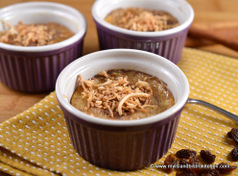
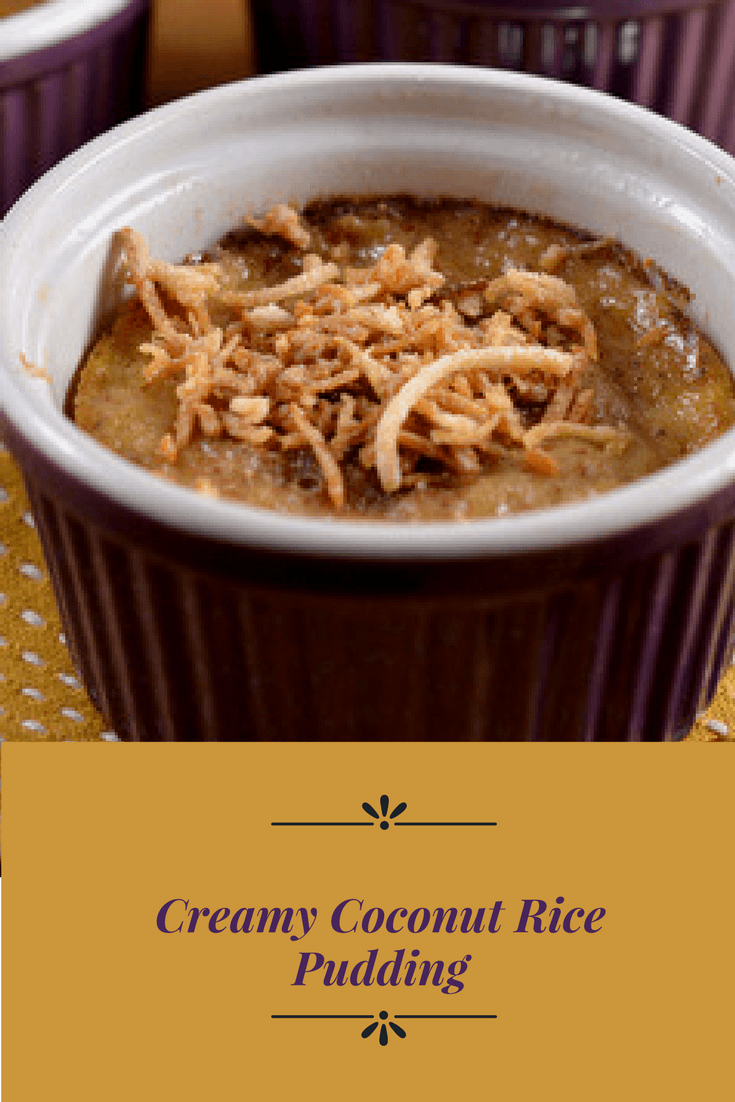
It’s a new year so it’s a good time for readers to familiarize themselves with the acceptable use of content from this blog.
The “Disclaimers and Terms and Conditions of the Use of Material on this Food Blog” document has been updated effective today, January 13, 2016.
Readers and users of recipes from this website are STRONGLY encouraged to read this document that can be found here and to ensure that they comply with the stated terms and conditions of acceptable use of content from this blog. This document also covers copyright issues as well.
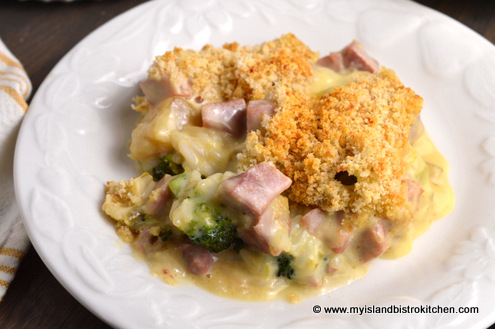
I cooked a boiled dinner with ham that I got on a great deal so am fortunate that the ham has a lot of meat on it. You can get my method for making a boiled ham dinner here. After sandwiches and leftovers for a night or two, it was time to find other uses for the rest of the ham and ones that would extend the use of the meat into more servings than simply slicing and plating it. I am not one to throw out food so I always find ways to use up leftovers.
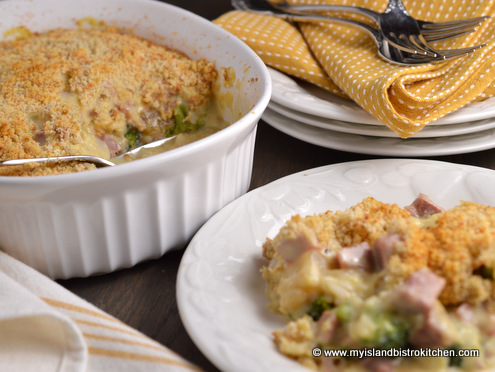
So, I made what I call a Hawaiian Fiesta Casserole aptly named because, in addition to the ham, it has pineapple, rice, and bright green broccoli florets. This casserole is not difficult to make but it does take a bit of time, planning, and coordination since the rice and broccoli have to be pre-cooked and the pineapple fried (yes, fried). Continue reading Hawaiian Fiesta Casserole
New Year’s Eve is the perfect occasion to bring on all the bling, glitz, and glamour …. and that includes dressing up the dining table. I thought you might be interested in taking a peek at how I transformed my dining room from Christmas into an elegant venue for a New Year’s Eve dinner. And, yes, each guest had a glittery and elegant silver or black hat to wear for the evening.
As you can see, the color theme was silver, black and white.
Each place setting was framed by a silver charger plate with a rhinestone edge.
A small glass dessert dish contained silver cola balls at each placesetting.

I used one of my napkin ring sets that has a lot of bling to contain the black napkin because, well, there’s no such thing as too much bling on NYE, is there!
I think the napkin looks very stylish and elegant placed diagonally over the edge of the plate and charger. For elegant and sophisticated tablesettings, always use a high quality cloth napkin.
Of course, any “blingy” tablesetting needs lots of glassware to reflect the light. Each placesetting had three glasses – a water glass, a white wine glass, and a champagne flute. When I am setting an elegant table, I try to make sure the glassware all matches. For more casual tablesettings, mix-and-match glassware may work but, for formal settings, I use matched glassware. The more cuts there are in the glassware, the more dazzling it is in different lighting situations.
I went with a very simple centerpiece. Two glittery silver pillar candles on medium-height glass candlesticks and a white and deep rose floral arrangement in a small black urn.
For the floral centerpiece, I used bright rose-colored Gerber daisies surrounded by a collar of white carnations with green berry highlights.
With all the white, silver, and glass on the table, I thought the centerpiece needed a bit of bright color to stand out.
Simple yet elegant.
And, of course, there were little Hershey kisses for midnight! It’s all about the little details!
Here’s an overhead view of the table. Once I set a table, I always take a photo as that will quickly let me see what’s out of place and needs adjustment. Amazing how a photograph will reveal what an eye does not always see!
To keep the glitz going, I hung some mirror balls, glittery snowfakes, and glass from my dining room lighting fixture.
These are simply inexpensive ornaments I purchased at a dollar store. They do the trick!
Glittery snowflakes!
My fireplace mantle featured winter white and black. Tick-tock as we made our way to midnight!
The black lanterns tied in with the black on the table and provided the glow of soft candle light as evening darkness settled in.
The champagne bucket was filled with ice.
And the champagne flutes stood at the ready.
Then, the beverage was poured…..
And, before long, it was the midnight hour!
I hope you have enjoyed this glimpse into my New Year’s Eve dining room. Best wishes for health, happiness, and prosperity in the new year. Happy New Year, everyone!
To view other seasonal tablesettings, click on the links below:
Christmas Eve Tablesetting and Dinner
Twas the Night Before Christmas
The Warmth of the Christmas Light Tablesetting
A Tartan Holiday Tablesetting
Pretty Poinsettia Tablesetting
Poinsettia Trio Tablesetting
The Holiday Table
The Pink and Green Holiday Table
Christmas at My Island Bistro Kitchen
Purple Tablesetting for the Holidays
Evergreens and Reindeer Christmas Tablesetting
Cupcake Tablescape
—————————————————————————-
Thank you for visiting “the Bistro” today. If you enjoyed this posting, please share it on your social media websites.
Connect with “the Bistro” through the following social media:
Join My Island Bistro Kitchen on Facebook
Follow “the Bistro’s” tweets on Twitter
Follow “the Bistro” on Pinterest
Follow “the Bistro” on Instagram
——————————————————————————
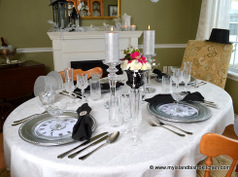

By now, if you are a regular follower of this food blog, you have probably detected that I am a big fan of cranberries! I am always developing recipes using these tasty morsels. Continue reading Chunky Cranberry Salsa

While cranberry sauce is traditionally associated with Thanksgiving and Christmas, I eat it year-round. In fact, I batch cook it and freeze it for use throughout the year.
Each fall, I eagerly await the cranberry harvest on PEI. The photo below was taken on a day that Mikita Farms in Farmington, PEI was wet harvesting their cranberry crop. Produce just does not get any fresher than this!
In the fall, I buy a huge bag of cranberries for the freezer as I use them in several recipes, including cranberry-orange sauce.
These gems turn into a rich jeweled-toned cranberry sauce.
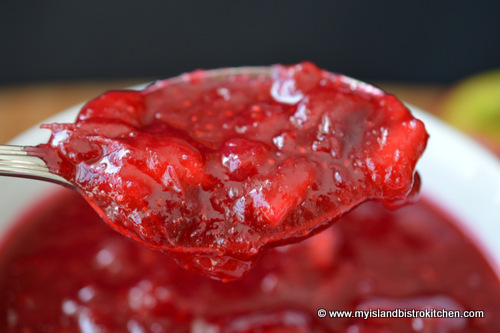
Any time I am cooking a chicken dinner, chicken pieces, or have a craving for cranberry sauce, I head to the freezer for a small container of the sauce as it just seems to make the meal.
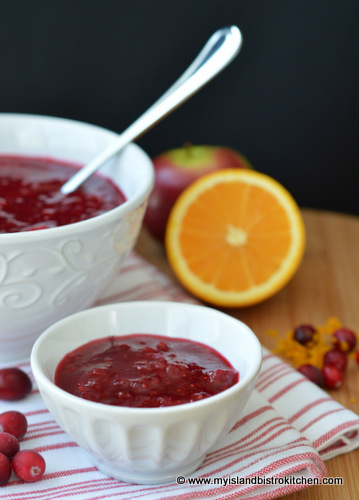
I hope you enjoy my recipe for cranberry-orange sauce. This is not a sickeningly sweet sauce although you can add a bit more sugar if you have a really sweet tooth! Adding some apple and orange juice to the sauce gives it an extra flavour boost and both fruits complement the cranberry flavour well. While the sauce is lovely without the Cointreau, it does add to the flavour of the sauce.
The method I use for the sauce is to make a simple syrup by boiling the sugar and water and then adding the cranberries, apple, and orange juice. I don’t care for runny cranberry sauce so I have learned this tip from my mother: Occasionally stir the sauce as it is cooking but make sure you stir it several times as it cools as this will help to thicken the sauce.
Don’t save this zesty cranberry-orange sauce for the holidays; enjoy it year-round!

Ingredients:
1 cup granulated sugar
1 cup water
2 cups cranberries, fresh or frozen
½ cup apple, finely chopped
1/3 cup orange juice
1 tsp finely grated orange rind
1½ tbsp Cointreau (optional)
Method:
In medium-sized saucepan, bring sugar and water to boil. Boil, uncovered, for 5 minutes over medium-high heat, stirring occasionally.
Add cranberries, apple, and orange juice. Bring to a boil. Cook over medium-low heat, stirring periodically throughout the cooking process for about 15 minutes or until mixture thickens.
Remove saucepan from heat and add orange rind and Cointreau. Stir several times as the sauce cools to help it to thicken.
Store, covered, in refrigerator for up to 5 days or freeze for longer storage.
Yield: Apx. 2 cups.
A mildly tart and flavorful sauce that pairs well with roast turkey and any poultry dishes
Ingredients
Instructions
Red Wine Cranberry Pear Sauce
Cranberry Rhubarb Sauce
Cranberry Blueberry Sauce
Join the Facebook page for My Island Bistro Kitchen: https://www.facebook.com/MyIslandBistroKitchen/
Follow “the Bistro” on “X” (formerly Twitter): https://twitter.com/PEIBistro/
See the drool-worthy gallery of mouth-watering food photos from My Island Bistro Kitchen on Instagram: https://www.instagram.com/peibistro/
Follow “the Bistro” on Pinterest at https://www.pinterest.ca/peibistro/ and pin the Pinterest-ready photo found at the end of this post to your favorite Pinterest boards.
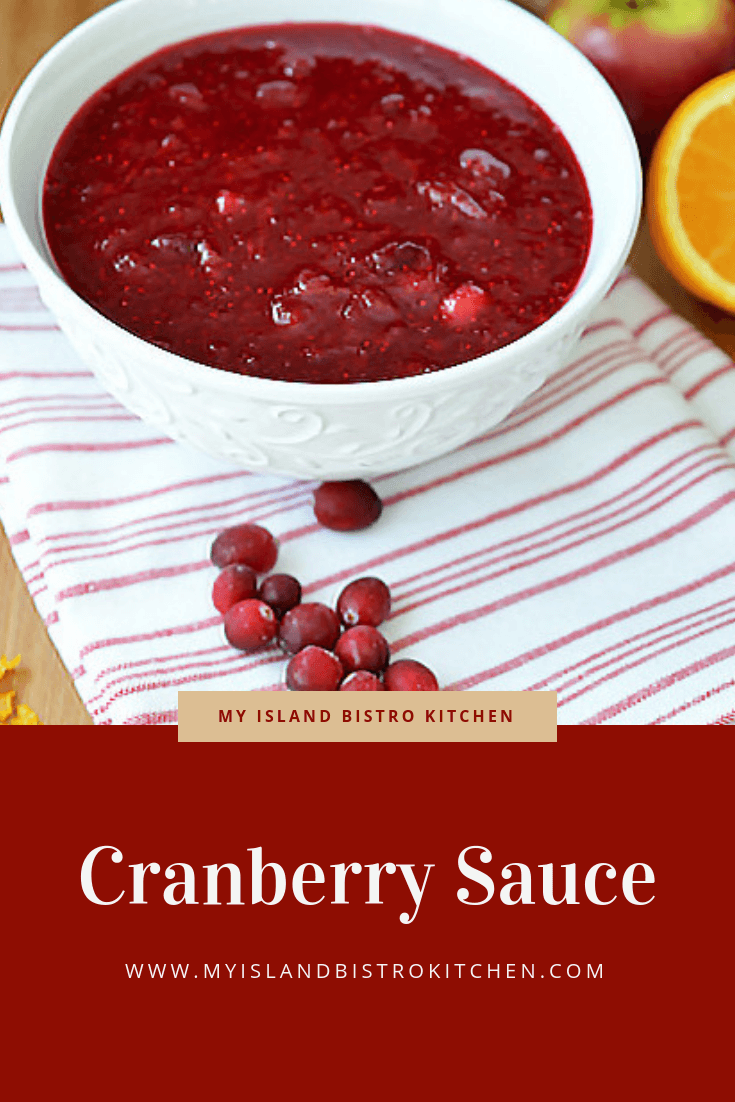
The Dinnerware
Johnson Brothers’ “Twas The Night” dinnerware is classic Johnson Brothers in every way. The dinnerware features nostalgic scenes and text from the classic Christmas story “Twas the Night Before Christmas“.
Made of earthenware, this is a sturdy, durable easy-to-care for set of dinnerware that is both dishwasher and microwave safe.
This tableware has a distinctively pinkish-red and ivory color and, with text from the afore-mentioned Christmas story, it is definitely Christmas-only dinnerware. For this reason, I have chosen it for Christmas Eve dinner.
Let’s take a look at the intricate pattern on each plate and the bowl.
The dinner plate features the exterior of an old stone house.
The salad plate shows a tree by the fireplace with stockings hung.
The soup bowl shows a full moon in the winter sky over the rooftop.
Even the bottom of the plates has detail.
As those of you who follow the tablesetting part of my food blog will know, I’m a big fan of charger plates, both for their functionality and for the color and elegance they lend to a tablesetting. However, as I have discovered, not all dinnerware necessarily benefits from the use of charger plates. This Twas the Night pattern is a prime example of that. I did try pink chargers under the plates but found the dinnerware too informal and, for my taste, the chargers looked out of place. This, of course, does not mean a pretty table cannot be set with these dishes.
Glassware
Because this dinnerware is more vintage in design, I have chosen glassware in styles that complement the dishes. This is dinnerware that allows mix-and-match glassware. In fact, none of the three vintage glasses are a matched set yet they seem to work in this setting. The stem glasses with red trim give a bit of extra pop of color to the tablesetting and blend in with the red berries in the jars.
Linens and Napkins
It is not often that I set a table without either a full tablecloth, a square, or placemats. However, for this setting, I have chosen to use a short Christmas runner down the center of my oval table and let the maple wood of my table shine. I think this complements the informal casual look of this dinnerware.
When selecting napkins, I try to choose them in a color that either matches the background color of the dinnerware or, alternatively, select a color from the pattern. In this case, I have opted to go with ivory napkins and the fold I have chosen is the rose.
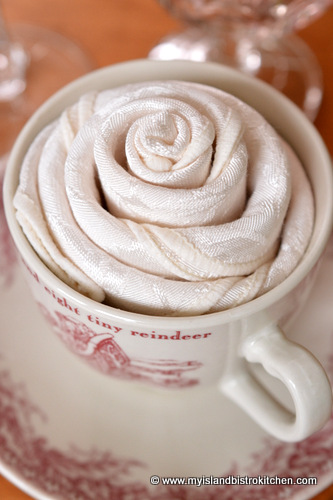
This is a simple-to-do napkin fold. I like to use this fold when space on the table is limited to display a napkin, when a napkin fold would substantially cover up the dinnerware pattern which is a focal point of the table, or when placement of the napkin would clutter up, or compete with, a simplistic tablescape design.
The rose fold requires either a soup bowl or a cup to contain it and hold it in place. This method of styling and presenting a napkin is unpretentious yet gives the look and feel that planning and effort have been put into the tablesetting.
Tablescape/Centerpiece
Since my goal with this setting is to keep it very simplistic, I have chosen to use standard glass canning jars of two sizes for the table decor. You may know these as Mason or Ball brand jars.
In the three larger jars, I have added a base of Epsom salt to resemble snow topped with some faux red berries to symbolize cranberries. To add a touch of seasonal greenery, I have topped each jar with a few sprigs of fresh greenery.
In each of the smaller jars, I have placed a small white votive candle on a base of Epsom salt. Just make sure you put the candle in a small votive glass inside the jar to contain the melting wax.
Using an odd number of jars is more pleasing to the eye than if an even number was used. More (or fewer) jars can be used depending on the length of the table.
Using these glass jars is remaining quite popular and trendy probably because of their versatility. I think their “home-y” look blends well with the nostalgic tableware that has a homestead, casual look to it. When I think of homestead, I think of canning fruits and vegetables which is the traditional use of these jars.
This dinnerware is sure to be a conversation piece on the dinner table for many Christmases to come.
To view other Christmas Tablesettings, click on the links below:
Glitz ‘n Glamour New Year’s Eve Tablesetting
The Warmth of the Christmas Light Tablesetting
Christmas Eve Tablesetting and Dinner
A Tartan Holiday Tablesetting
Pretty Poinsettia Tablesetting
Poinsettia Trio Tablesetting
The Holiday Table
The Pink and Green Holiday Table
Christmas at My Island Bistro Kitchen
Purple Tablesetting for the Holidays
Evergreens and Reindeer Christmas Tablesetting
Cupcake Tablescape
Thank you for visiting “the Bistro” today. If you enjoyed this posting, please share it on your social media websites.
Connect with “the Bistro” through the following social media:
Join My Island Bistro Kitchen on Facebook
Follow “the Bistro’s” tweets on Twitter
Follow “the Bistro” on Pinterest
Follow “the Bistro” on Instagram
——————————————————————————
Sugar and spice and everything nice! That pretty much sums up the smell in the kitchen when these Molasses Spice Cookies are baking. These cookies have a lovely blend of spices that make them a real taste treat, especially with a tall glass of cold milk. Continue reading Molasses Spice Cookies
Many will buy wine over the holiday season either for their own home entertaining events or for gifts. Sometimes, if you are like me, when I enter the wine section of a store, it can be puzzling to make a selection from the wide array of wines on the market. To gain some insight into making some wine choices this holiday season, I enlisted the help of sommelier Debbie Smith. In addition to being a sommelier, Debbie also works as a product adviser at the Prince Edward Island Liquor Control Commission at their Oaktree store in Charlottetown. I thought readers of my food blog might also be interested in what I learned so I am sharing the insights.
Readers will note that wine selection is very much based on personal taste and preference. There are as many opinions on wine choices as there are wine drinkers and sommeliers; however, what follows are the views and suggestions of one sommelier in direct response for advice I was personally seeking so are meant as just that — – suggestions one might consider when selecting wines to pair with certain typical holiday foods. It does not mean that other wines not suggested, or named in particular, would not be fine pairings, too. As a further note, prices are in Canadian dollars and are current as of the time of writing in December, 2015. The reason I asked for price points is that I find it useful to know if a wine suggestion is, say, less than $20.00 or more than $50.00 per bottle.
Debbie, a certified sommelier and graduate of the Canadian Association of Professional Sommeliers, has been a sommelier for eight years. Prior to her current position, she worked as a sommelier and wine trainer with the Murphy Hospitality Group in PEI. She became interested in learning more about wine in order to raise the level of service she was providing to patrons in the restaurant industry. Debbie says she was fortunate to work with one of the Island’s first accredited sommeliers who was very enthusiastic about the field and this increased her interest in learning more about wine.
To begin, I asked Debbie if price is an indicator that the more expensive the wine is, the better its quality. Debbie indicates that, while price point can be a general indicator on the quality of wine, it is only part of the equation. She points out that wine preference is such a personal experience, other factors come into play — the occasion, budget, personal preference, and past experience with wine. Debbie points out that the general indicators of a good wine include its complexity, intensity, balance, and finish. So, the more different notes and distinct flavours you can pick up on, identify, and distinguish in the wine and how harmonious the fruit, tannin, acid, body and alcohol level are (with none outshining another) along with how long the flavours and sensations remain in your mouth after you have swallowed will indicate a quality wine.
My first question was what general factors should one think of, or consider, when making wine selections for pairing with different foods. Debbie suggests that flavour and intensity are key considerations. For example, the flavours and intensity of the food and wine should match so one does not overpower the other. Since lobster is often served in Prince Edward Island over the holiday season (and is our traditional fare on Christmas Eve), Debbie uses the example of lobster served with a rich creamy sauce pairing well with a rich butter US Chardonnay while lobster served out of the shell with fresh lemon could be paired with a crisp citrusy Sauvignon Blanc from the Loire in France.
I asked, if I was hosting a dinner party, how important it would be to serve a different wine with each course. She says it really isn’t critical and many people focus on pairing a wine with the main course specifically. That said, however, if budget allows, it does contribute to the dining experience if different wines are served with the various courses of the meal.
My next question was, if budget is a concern, is there one general wine she could recommend for a holiday meal. In this scenario, Debbie suggests what she calls “crossover wines”, those that have the ability to pair well with a number of different food styles. Pinot Noir and Chardonnay, for example, are considered versatile wine choices since both can pair well with chicken, pork, salmon, and less marbled cuts of beef like tenderloin. Wines that might fall into this category could include OPI Chardonnay from Argentina ($15.99 CDN$), Arbodeda Chardonnay ($16.99 CDN$), or Chile Cono Sur Pinot Noir ($13.99 CDN$).
To get a little more into specific food and wine pairings for typical holiday foods and events, I asked for Debbie’s advice on what wine would be best to serve in the following scenarios:
Seafood chowder is a fairly common starter on many menus in the Maritimes over the Christmas holidays so I asked for information specifically on wines that would be suitable to pair with rich seafood chowders. Debbie suggests a wine such as L’Acadie Blanc styles (price points $17-22 CDN$) from the Maritime Provinces because, in her words, ‘what grows together goes together!” White wines from grapes grown in the Maritime Provinces offer crisp acidity and slightly sweet aromas which are an ideal match for a rich cream-based chowder made with the fine seafood from the Atlantic Ocean.
To pair a wine with a green salad, Debbie suggests Vinho Verde styles from Portugal and New Zealand Sauvignon Blanc (price points $14-23 CDN$) because the key is to match the level of acidity when pairing wine successfully with green salads. She suggests that the Sauvignon Blanc often has distinct tropical fruit and grassy aromas with a good acidity level that are perfect complements to a salad. In Debbie’s opinion, the Vinho Verde is a unique style of wine noted for its slight effervescence, vibrant fruit, and refreshing qualities that make it a great pairing with salads. For the green salad course, then, I might consider either Gazela Vihno Verde ($13.60) or Quinta da Aveleda Vihno Verde ($14.50).
There is no need to break the budget for a good wine to complement the traditional roast turkey dinner. Debbie suggests an off dry Riesling from either Canada or Germany and several can be purchased for under $20 (CDN$). She suggests, because the dinner itself can be heavy, choosing something light to moderate in alcohol that has high acidity to balance the richness and add a bit of sweetness to match the cranberry and yams on the table. For this course, then, I might consider Beaujolais Nouvalle ($18.99-20.99) or a wine produced in St. Catherine’s in my home province of PEI – Matos Gamay Noir ($16.95).
Desserts over the Christmas season can often be rich and heavy. For many of us, that might include traditional plum pudding. For this course, Debbie suggests choosing a wine that is as sweet as the dessert. She recommends a slightly chilled tawny port from Portugal because the port is full of flavours of caramel, apricot, plum, and raisins which would complement the similar flavours in the pudding. Ports tend to be slightly more pricey so this option would require me to be prepared to pay $30 or more (CDN$)
For many families, particularly those of Acadian descent, it would not be Christmas without the traditional meat pie. For this repast, our sommelier’s suggestion is to choose a wine that is rich, savoury, and spicy to complement the similar flavours in the pie. Cote du Rhone and Grancha Syrah Mouvedere (GSM) blends from France and Australia would, in Debbie’s opinion, be good choices and they range from $15-30 (CDN$) or, for a truly Acadian experience, one might try Baco Noir, Machel Foch, and other wines produced in the Atlantic Canada region.
I was curious to know what a sommelier might suggest as a wine accompaniment for a brunch. While recognizing that a brunch might have a number of different items on the menu, Debbie suggests a sparkling wine or, indeed, a Champagne to accompany croissants, pancakes, and even muffins because of the buttery yeast flavours in these foods. If bacon is on the menu, she suggests light oak Chardonnays with butterscotch and vanilla flavours would play well with the salty smoky qualities of the bacon. If steak and eggs are on the menu, a Merlot that has notes of black cherry, green pepper, and minerals might be considered. And, if spicy sausage is a featured menu item, a chilled Beaujolais red berry with low tannins to offer a good contrast to the spice and heat in the meat would be a good pairing.
These two make a fine pair! The cheese is meant to bring out the character of the wine and the wine, for its part, enhances the depth and flavour in the cheese. Debbie claims that Gewurtraminer, with its sweet and fruity components and balancing acidity, offers the most opportunity for successful pairing. This is because the combination of sweetness and salt is pleasing to the palate. So, considerations could include Pelee Island Gewurtraminer from Canada ($12.99 CDN$) or France’s Wolfberger Vin D’Alsace Gewurtraminer for $18.99 (CDN$).
If goat cheese is being served, Sauvignon Blanc would be a suitable choice with its natural high acidity which tends to pair very well with the tart flavours commonly found in various goat cheeses. Selection suggestions could include Matua Sauvignon Blanc ($19.99 CDN$) from New Zealand or Paul Mas Sav Blanc Single Vineyard Collection for $15.99 (CDN$) from France.
For stronger flavoured cheese (like Gorgonzola, for example) Debbie recommends Coltibuono Chianti Classico from Italy ($22.95 CDN$) with its earthy notes and good acidity or the full-bodied Red Guitar Tempranillo and Granacha blend from Spain ($15.99 CDN$).
The sommelier suggests choosing a wine that blends sweetness with some acidity for the sweet treats we often associate with Christmas. Either Apothic Red Blend from the US ($16.99 CDN$), Criollo – a chocolate raspberry liqueur from South America ($19.99 CDN$) or, if you have the budget, Cockburn 20-year old tawny Port would make a fine pairing for chocolate but is a bit on the pricey side at $42.99 (CDN$).
For many, it is not New Years Eve unless there is a glass of bubbly and some of the champagnes can be pricey. However, there are many choices at different price points and these include the modestly priced La Marca Prosecco from Italy at $17.99 (CDN$), Benjamin Bridge Brut from Canada at $44.95 (CDN$) and the more expensive Bollinger Brut Champagne Special Reserve NV from France at $74.98 (CDN$).
But, if champagne is not your beverage of choice and you still want something a little sparkly with some effervescence, you might consider Benjamin Bridge Nova 7 from Canada priced at $24.99 (CDN$) or Jost Vineyards’ Selkie Frizzante $19.95 CDN$) also from Canada. Patrons of the PEI Fall Flavours Culinary Festival will recognize the Benjamin Bridge name since this winery was the official wine sponsor of the 2015 festival and their wines, including the fabulous Nova 7, were served at many of the culinary events. The Nova 7 will be my choice for New Year’s Eve celebrations this year.
The temperature of the wine is important to savour its true qualities. If you are not sure of the optimal serving temperatures for various wines, here are the recommended serving temperatures, according to the sommelier:
White wines: Full bodied 11°C; Light-bodied 9°C
Red wines: Full-bodied 18°C; Light-to-medium-bodied 12-15°C
Rosé wines: 5°C
Sparkling wines: 6°C
Champagnes: 6-7°C (8°C for vintage champagne)
Wine is often chosen as a host/hostess gift but it is sometimes a quandary to know what wine to select, especially if you don’t know the recipient’s tastes so I asked Debbie for her recommendation if one is faced with this scenario. She recommends either a Pinot Grigo, such as Gabbiano from Italy currently priced at $14.99 (CDN$), or Norton Privada Malbec for $24.95 (CDN$). Malbec, at the time of writing, is a trendy favourite.
Before we concluded our discussion on wine and food pairings, I asked Debbie if there are any new or up-and-coming wines or regions we should know about. She says that, although New Zealand has been producing wines since the 1800s, it has really come in to its own as a wine region within the last 20 years, particularly with wines such as Kim Crawford. In fact, New Zealand will be the featured wine country for the 2016 Festival of Wines Prince Edward Island to be held May 27-28th at the Eastlink Centre in Charlottetown. And, of course, our own three PEI wineries, along with a number of others in New Brunswick and Nova Scotia, here on Canada’s East Coast, are proof that our cool climate is also very suitable for growing a number of different kinds of grapes that produce fine wine.
To finish off, I asked Debbie some “quick snapper” questions.
1. What wine(s) will be on your 2015 Christmas table and why that particular choice? I will be serving two wines at this year’s dinner. The first is Dr Heidemanns Bergwilier Riesling Kabinett ($24.99 CDN$) from Mosel region in Germany because this is a dry Riesling with notes of black currant and apricot with a structured finish which makes it a wonderful pairing with turkey. The second wine is Gabriel Liogier Vacqueyras ($26.89 CDN$), a red wine from France that is full bodied and a bit spicy, making it a perfect pairing with both roasted vegetables and turkey.
2. What is your personal favourite food and wine combo? Growing up in rural PEI, my favourite meal will always be meat and potatoes so my choices would be Barolo, Amarone, or Cabernet Sauvignon which are full bodied red wines with good tannin levels that all match the texture and intensity of beef.
3. What is the one wine you’d recommend people try this holiday season and why? I’d suggest Jolie-Pitt Perrin Cotes du Provence Rose Mirval from France because it has such beautiful white cherry and dried peach accents with a refreshing finish. It would be a treat after all the rich dinners and desserts we indulge ourselves with over the holidays. It currently sells for $30.95 (CDN$). I’d also suggest Mark West Pinot Noir at $18.99 (CDN$) which is smooth and subtle with toasty oak and espresso notes.
4. What’s the number one question you get asked as a sommelier/product advisor during the holiday season? I am often asked to provide food and wine pairing information and suggestions but, during the holiday season, the most common question is “What do I buy my boss/friend/co-worker who knows everything about wine?” My response to the question is: “I would choose some more interesting styles and grape varieties and in particular I would choose one one of the following: KWV Cathedral Cellars Pinotage from South Africa ($20.99 CDN$) with its aromas of sweet fruit, black pepper and cedar or De Bortoli Noble One Botrytis Semillon from Australia ($30.99 CDN$) with its layers of intense botrytis fruit including citrus, marmalade, and hints of butterscotch, or Firesteed Pinot Noir from Oregon in the US ($24.99 (CDN$).”
5. If you were abandoned on an island and could have only one bottle of wine with you, what would it be? Cristal 2007. It retails for $295 (CDN$) but would be worth the price to celebrate my rescue! It’s truly an amazing product.
6. If you had to give one piece of advice for pairing wines with meals, in general, what would it be? “It’s your palate so drink what pleases you. In general, I think making sure the intensity and textures of the food and wine are equal are the most important (factors to consider).”
My thanks to sommelier Debbie Smith for taking the time to assist me with wine selections to pair with holiday foods I will be serving this year. Sommeliers and in-store product advisers are great resources and can help with wine selections so don’t hesitate to seek them out with your specific questions as I have done. They are trained to help in the way Debbie assisted me with my wine-related questions.
—————————————————————————-
Thank you for visiting “the Bistro” today. If you enjoyed this posting, please share it on your social media websites.
Connect with “the Bistro” through the following social media:
Join My Island Bistro Kitchen on Facebook
Follow “the Bistro’s” tweets on Twitter
Follow “the Bistro” on Pinterest
Follow “the Bistro” on Instagram
——————————————————————————

I am not sure why but a red plaid pattern evokes thoughts of Christmas for me. As I have discovered, red tartan dishes lend themselves well to setting a beautiful holiday table.

Dinnerware
The dishes I have chosen for a holiday dinner are by designers Colin + Justin. Apart from the dynamic look, there are several things I like about this dinnerware pattern.
First, the dinnerware has the look and feel of fine china, complete with gold-colored trim, but is actually easier to care for since the dishes are both dishwasher and microwave safe. Second, they can work effectively either in a formal or informal tablesetting. In fact, I’d suggest they are quite contemporary in look and design and could easily transition from breakfast/brunch to lunch to dinner. And, third, they don’t scream Christmas which means they can be used throughout the fall and winter months. With their dark color, they would be a bit heavy for spring and summer, in my view, but I would certainly use them from October to March.

The dinner plate has a white center so food will still stand out against the plate. I’m a big fan of white plates for food presentation! This dinnerware gives the benefit of a nice plaid border against the white center.
The salad plate is a full tartan design. The dinnerware has the versatility of allowing for an exchange of a plain red, green, or white plate with the plaid salad plate for added contrast to the setting or to change it up for different occasions.
The bowl is white inside so the soup color certainly stands out.
Linens
The dinnerware with its bright red and green plaid has a somewhat heavy look to it so it needs some bright white neutral contrast on the table for it to stand out. For this reason, I have chosen to use large plain white placemats as the base for each place setting. The white connects to the center of the dinner plates and bowls – always try to connect the linens somehow to the dinnerware pattern. If, for example, I had chosen red or green placemats or a full tablecloth in either of these heavier colors, the dinnerware pattern would have been lost and would not have stood out. And, sometimes, I just want to see the maple wood in my table and placemats allow for that. The placemats are also in keeping with the contemporary look of this setting.

If you are not knacky with napkin folding, or simply don’t have time, using napkin rings is an easy alternative solution. I think of napkin rings as the jewelry on the table.

I bought these beautiful poincettia napkin rings on an after-Christmas sale last year and think they go particularly well with this dinnerware. With their deep red color, they need a bright white napkin for their color to pop. The white napkin, of course, connects to the white placemat.
Apart from the speed and ease of threading a napkin through a ring, napkin ring-folded napkins can be placed in various locations at a placesetting — to the left-hand side beside the fork, in front of the plate if space allows, or laid across the plate or atop a soupbowl (as I have done in this setting) if table space is at a premium or you simply want to add some pizzazz to the top of a placesetting.
Centerpiece/Tablescape
For the tablescape, I pulled in colors from the dinnerware.
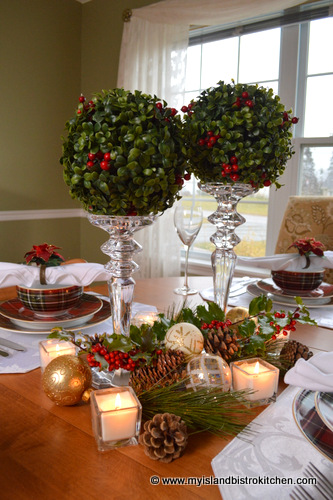
I have opted for a relatively simple and easy-to-construct centerpiece – two faux green kissing (or pomander) balls on high glass pillar candlesticks surrounded by greenery, holly berries from outside my front door, Christmas balls, and pinecones to fill in some empty spaces.
Since I am not a huge fan of taper candles that can easily tip with a guest’s knee jerk against the table, I have chosen to use a series of small white votives interspersed along the edges of the centerpiece. They add a lovely upward glow to the kissing balls which are the focal point of the tablescape.
One of the things I am doing this season in my tablesettings is trying to use existing product and props in my centerpieces as opposed to buying more or always opting to use fresh flowers. As lovely as fresh flowers are, they do require some work and, if I want to set my table well ahead of an event as my time allows, it’s easier if I use other options for centerpieces. Additionally, if you already have suitable props, it’s a more economical option.
Glassware
Because this dinnerware is quite modern, I am using extra-tall and very contemporary wine glasses. The height of the glasses complements the high centerpiece as well as the dinnerware.
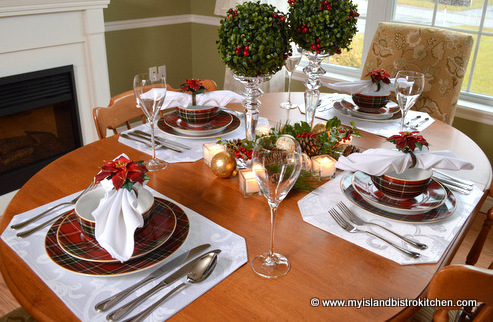
I hope you have enjoyed my contemporary tablesetting using red tartan dinnerware. Happy Holidays!
To view other Christmas and New Year’s Tablesettings, click on the links below:
Glitz ‘n Glamour New Year’s Eve Tablesetting
Twas the Night Before Christmas
The Warmth of the Christmas Light Tablesetting
Christmas Eve Tablesetting and Dinner
Pretty Poinsettia Tablesetting
Poinsettia Trio Tablesetting
The Holiday Table
The Pink and Green Holiday Table
Christmas at My Island Bistro Kitchen
Purple Tablesetting for the Holidays
Evergreens and Reindeer Christmas Tablesetting
Cupcake Tablescape
—————————————————————————-
Thank you for visiting “the Bistro” today. If you enjoyed this posting, please share it on your social media websites.
Connect with “the Bistro” through the following social media:
Join My Island Bistro Kitchen on Facebook
Follow “the Bistro’s” tweets on Twitter
Follow “the Bistro” on Pinterest
Follow “the Bistro” on Instagram
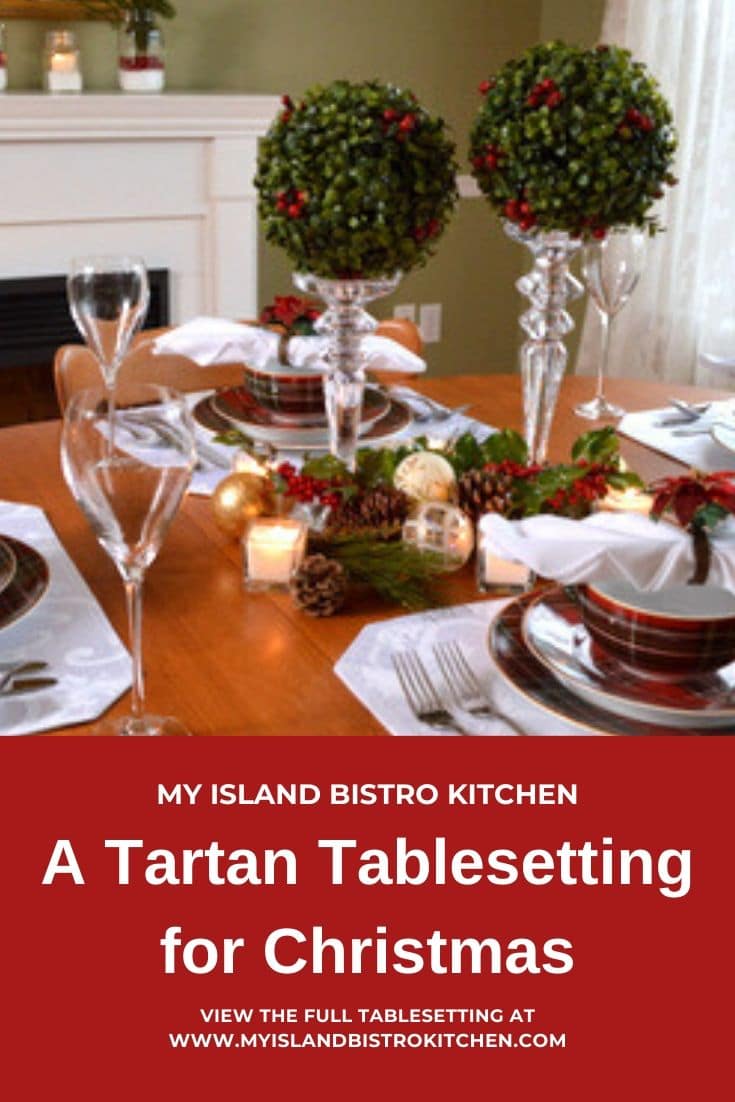
I love setting beautiful tables any time of the year but the Christmas season lends itself so well to many creative tablesetting options. Sometimes, I have many more ideas than I have need to create new tablescapes!
Today, I am veering off the traditional color theme one might ordinarily expect to see on a Christmas table though I have incorporated some red and green into the design.
The Dishes
The dinnerware I have chosen is manufactured by Royal Stafford in England. The pattern is called “Christmas Home”.
These earthenware dishes are durable and not nearly so fragile as fine bone china. The dinnerware is both microwaveable and dishwasher safe so, for this reason, the dishes are a suitable option for everyday use during the holiday season or they can be dressed up for a Christmas dinner as I have done here.
The predominant black/gray color may not be what one would think of first for Christmas dinnerware. However, look closer and you can see the black/gray makes a lovely frame for the heartwarming scene on the dishes. It really makes the red and green pop in the pattern.
As soon as I examined the scene, I knew my tablescape would draw its inspiration from the glow of light in the windows of the dinnerware pattern and I have called this tablesetting the “Warmth of the Christmas Light“. I like how the nostalgic pattern in the dishes tells its own story.
Charger Plates
I have a wide collection of charger plates and use them frequently in my tablesettings. They are as functional as they are decorative. They are functional as they help to keep each placesetting clean. If a morsel of food escapes a plate, the charger plate (as opposed to a fine tablecloth or wood table) catches it. Charger plates also allow for the elements of each placesetting to be coralled in an orderly fashion. From a decorative point of view, chargers add a touch of class, elegance, and color to a finely set table. Charger plates are very inexpensive and I have chosen basic black to complement the black and white dishes and the black lanterns in the tablescape.
Linens
When the dinnerware pattern is busy, I recommend choosing a plain tablecloth that matches the background color in the dishes. In this case, I have selected one of my white Irish linen tablecloths because the background in the dinnerware is white. The blank white canvas of the tablecloth allows for the elements of the tablescape to stand out.
I am a big fan of cloth napkins and, in particular, plain napkins. Plain linens are very important if the dinnerware has a busy pattern so neither competes with the other. The plain napkins help to ground the patterned dinnerware. To use patterned napkins and tablecloth with this dinnerware would make it very cluttered to the eye. To add some brightness to the tablescape and to tie in with the hints of red in the dinnerware and the bow on the lantern, I have chosen red napkins.

In keeping with my theme of the warmth of Christmas light, the napkin fold I have selected is the freestanding candlestick. This is a very easy-to-do napkin fold and a stiff napkin is required. The red napkins I have used have white trim on the edges so, when rolled into a candle shape, the white resembles candle drippings. If you find this napkin fold too tall for your liking, the napkins can always be laid across each place setting where they will appear as simple, elegantly rolled napkins.
Centerpiece
For the centerpiece on this table, I have used two black lanterns along with red pillar candles. I like to use props I already have and incorporate them into different table settings. The black lanterns blend well with the color of the dinnerware and are continuing the theme of light. I have dressed up the taller of the lanterns with a swag in colors complementary to the dinnerware along with a perky red bow. The lanterns also provide a safe place for the candles yet still allow them to add light to the tablescape. Some faux red berries and pine cones complete the look.
Glassware
To complement the nostalgic dinnerware, I have opted to use very traditional glassware of about average height for stemware.
I hope you have enjoyed my “Warmth of the Christmas Light” tablesetting that features Royal Stafford’s “Christmas Home” dinnerware.
To view other Christmas and New Years Tablesettings, click on the links below:
Glitz ‘n Glamour New Year’s Eve Tablesetting
Twas the Night Before Christmas
Christmas Eve Tablesetting and Dinner
A Tartan Holiday Tablesetting
Pretty Poinsettia Tablesetting
Poinsettia Trio Tablesetting
The Holiday Table
The Pink and Green Holiday Table
Christmas at My Island Bistro Kitchen
Purple Tablesetting for the Holidays
Evergreens and Reindeer Christmas Tablesetting
Cupcake Tablescape
—————————————————————————-
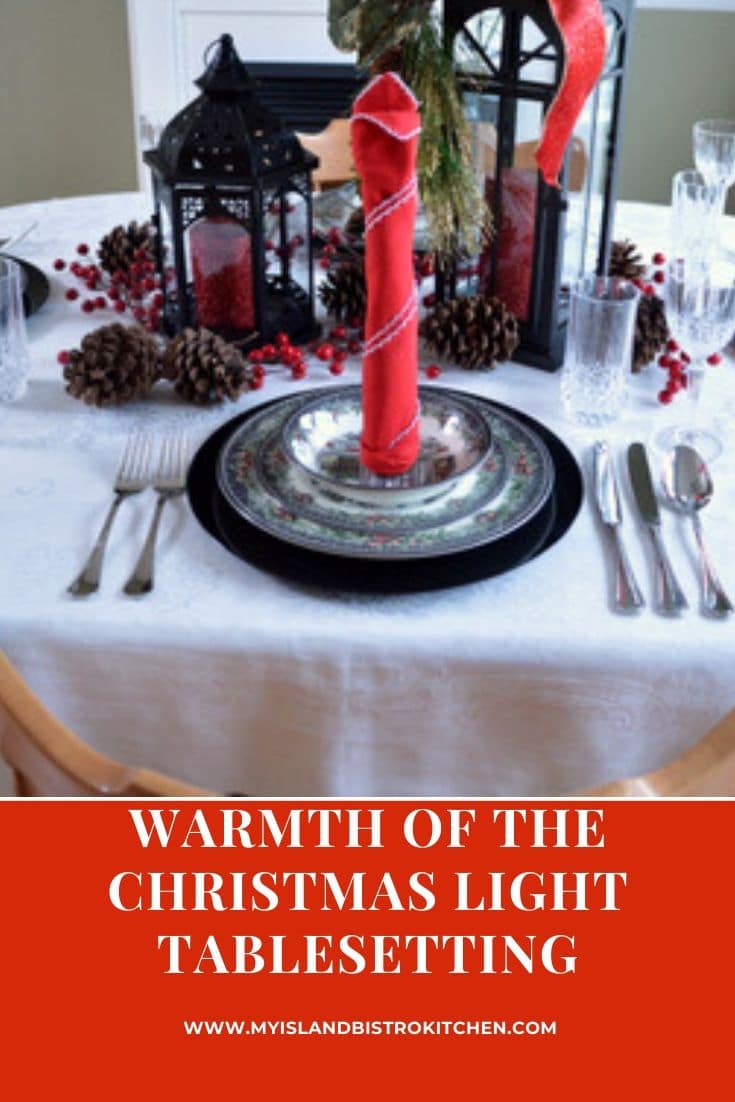
Thank you for visiting “the Bistro” today. If you enjoyed this posting, please share it on your social media websites.
Connect with “the Bistro” through the following social media:
Join My Island Bistro Kitchen on Facebook
Follow “the Bistro’s” tweets on Twitter
Follow “the Bistro” on Pinterest
Follow “the Bistro” on Instagram
——————————————————————————
As Christmas approaches and temperatures dip (at least for those of us who live in colder climates), my thoughts tend to turn to substantial “comfort” foods — visions of roast turkey, stuffing and gravy, cranberry sauce, fluffy mashed potatoes, and lots of root vegetables (such as carrots and turnip) enter my head. And then, of course, there are the dessert options. Traditionally, in my family, the main Christmas meal of roast turkey is followed by a rich steamed plum pudding served with a brown sugar sauce. You can get my recipe for plum pudding here.
However, there are other options for steamed pudding, particularly for those who prefer something a little lighter than the rich plum pudding. So, I am sharing my recipe for steamed cranberry pudding which is divine when served with a decadent eggnog sauce (recipe follows).
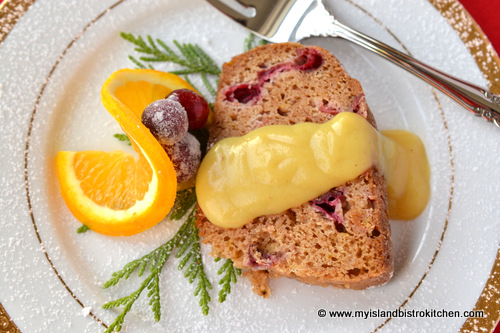
This cranberry pudding is super easy to make and, when paired with a smooth and silky eggnog sauce….well….you might want to have a second pudding on hand for those who have room for seconds!
This pudding is not highly spiced. It has just enough cinnamon, nutmeg, and cloves to give it subtle flavour. Either fresh or frozen cranberries may be used. In order to release their flavour, the cranberries should be coarsely chopped into about 2-3 pieces each for this pudding. Tossing the cut berries in some sugar while the batter is being prepared further draws out their flavour.
If you don’t have a steamed pudding mould like the one in the photo below, you can use clean tin cans or even a metal bowl. Simply spoon the batter into the cans or bowl, cover with a double thickness of heavy-duty tin foil, and secure it with string. The important thing is that, whatever vessel is used, it has a tight cover for the steaming process since the steam is what cooks the pudding and maintains the moisture without leaving the pudding wet and soggy. I used a standard 8-cup mould but I believe a 6-cup mould would suffice for this pudding.
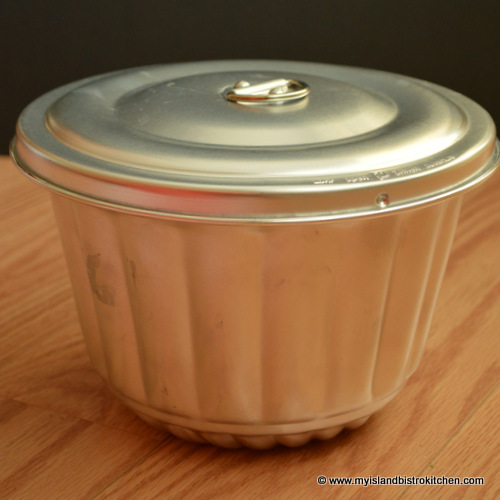
The advantages of using a pudding mould specially designed for steaming puddings is that it comes with its own cover and it also has a funnel in the center which helps the pudding to cook evenly and without falling. This, of course, is in addition to the attractive shape of the pudding when it is unmoulded and plated.
To steam this pudding, a large stock pot will be needed – one that allows enough room for the pudding mould to sit in the center of the pot and has at least 1 1/2 ” – 2 ” space all around the mould. A small wire rack that fits into the pot will also be required. This is what the mould needs to sit on as the pudding steams.
It’s important that the mould (or bowl or tin cans) not touch the bottom or sides of the pot as the water needs to circulate all around the pot (including underneath the pudding mould) in order for the pudding to cook evenly. Once the pudding mould is set on the wire rack, carefully pour in enough boiling water to come up to about the half-way point on the pudding mould. This is the level of water that must be maintained throughout the entire steaming process so additional boiling water may need to be added as the pudding steams. Once the boiling water has been added to the stock pot, cover the large pot with a lid and bring the water back to a full boil then immediately reduce the heat to a gentle boil.
Generally speaking, you’ll need to allot at least 1 1/2 – 2 hours for the pudding to steam over medium-low heat. This, however, is only an estimate and the true test is when a cake tester inserted into the center of the pudding comes out clean. I recommend removing the lid from the pudding mould and checking the pudding with a cake tester at the 1 1/2-hour point and then, if not cooked, about every 10 minutes after until the tester comes out clean. When the pudding is cooked, remove it from its water bath and place the mould on a wire rack. Let the pudding rest in the mould for about 20 minutes then remove the lid from the mould and transfer the pudding to a serving plate.
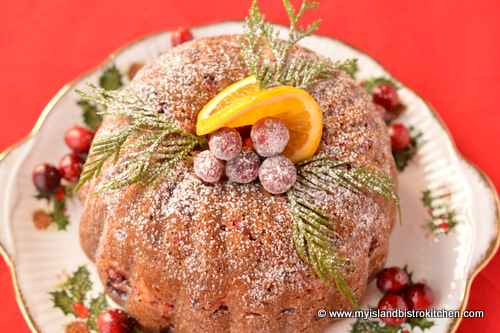
While this pudding would be well complimented by a traditional brown sugar sauce, it is particularly tasty served with a rich eggnog sauce. For ultimate flavour, the eggnog sauce is best served lukewarm, rather than piping hot, and can actually even be served quite cool. Because of the sauce’s richness, not a lot of the sauce is needed per serving. If you are an eggnog lover, you will love this sauce which would be equally good served over a bread pudding, too.
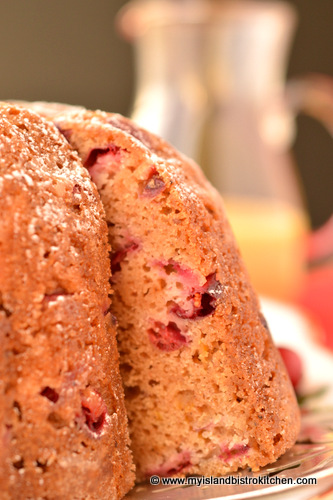
Ingredients:
1 1/3 cups coarsely chopped cranberries, fresh or frozen
½ cup butter
¾ cup granulated sugar (reserve ¼ cup for tossing with cranberries)
1 egg
1 tsp vanilla
2 tsp grated orange rind
1½ cups flour
1 tsp baking powder
1 tsp soda
¼ tsp salt
½ tsp cinnamon
¼ tsp nutmeg
1/8 tsp cloves
2 tbsp prepared eggnog
2 tbsp milk
1 tbsp Cointreau
Method:
Grease 6- or 8-cup pudding mould or spray with cooking spray.
Toss the coarsely chopped cranberries with ¼ cup of the sugar, ensuring the cut sides of the berries are coated. Set aside.
Cream butter and remaining sugar in large bowl. Beat in egg and vanilla. Add grated orange rind.
In separate bowl, sift the flour, baking powder, soda, salt, and spices.
In small bowl, whisk together eggnog, milk, and Cointreau.
Add dry ingredients to the butter-sugar-egg mixture alternately with the wet ingredients, starting and ending with the dry ingredients.
Lastly, fold in the cranberries. Transfer batter to prepared pudding mould. Cover tightly with lid. Place mould on wire rack in large pot and fill pot with boiling water to about half way up the side of the mould. Cover steamer pot with lid and bring the water to a full boil then immediately reduce the heat to a gentle boil. Steam the pudding over medium-low heat for approximately 1½ hours or until cake tester inserted into centre of pudding comes out clean. (NOTE: Add more water to pot as necessary to maintain the water level at about the half-way point on the pudding mould during the entire steaming process.) Remove mould from water bath and place on wire rack and let rest for 20 minutes then turn pudding out onto serving dish and serve warm with Eggnog Sauce (recipe below).
Yield: Apx. 10-12 servings
Ingredients:
2/3 cup sugar
1½ – 2 tbsp cornstarch
¼ tsp nutmeg
2 cups prepared eggnog
2 tsp vanilla
3 tbsp Cointreau
2 tbsp butter
Method:
In small bowl, combine the sugar, cornstarch, and nutmeg.
Pour eggnog into large microwaveable-safe bowl. Whisk in dry ingredients until smooth. Cook on HIGH until mixture is thickened to desired consistency, stirring after each 1½ minutes. Remove from microwave and stir in vanilla, Cointreau, and butter. (Note: Sauce will thicken slightly more as it cools.)
Sauce is best served lukewarm, spooned over individual slices of Steamed Cranberry Pudding.
Yield: Apx. 2 cups
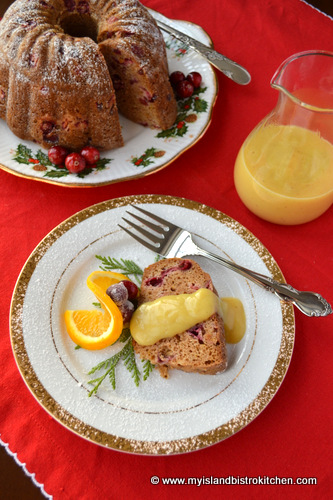
A tasty steamed pudding served with smooth and silky eggnog sauce
Ingredients
Instructions
Traditional Classic Plum Pudding
Steamed Carrot Pudding
Steamed Mincemeat and Apple Pudding
Join the Facebook page for My Island Bistro Kitchen: https://www.facebook.com/MyIslandBistroKitchen/
Follow “the Bistro” on “X” (formerly Twitter): https://twitter.com/PEIBistro/
See the drool-worthy gallery of mouth-watering food photos from My Island Bistro Kitchen on Instagram: https://www.instagram.com/peibistro/
Follow “the Bistro” on Pinterest at https://www.pinterest.ca/peibistro/ and pin the Pinterest-ready photo at the end
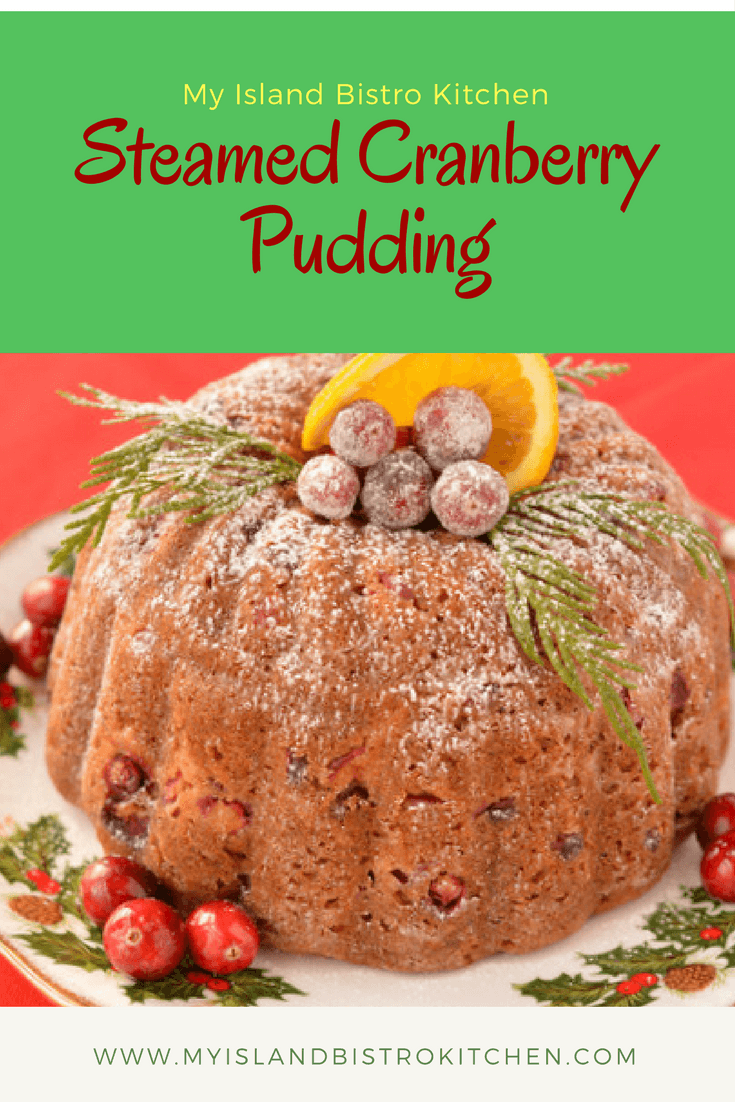
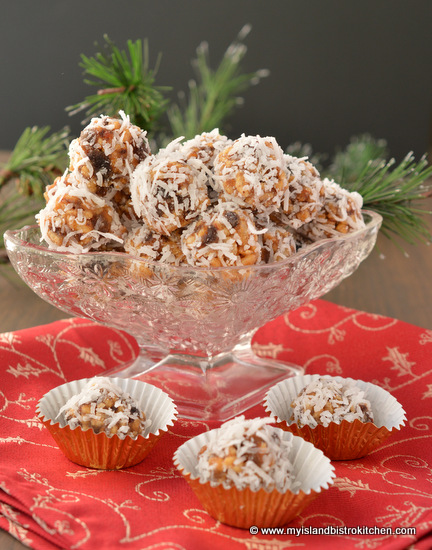
I have no idea why these tasty morsels are called cookies because, in my view, they in no way resemble my definition of a cookie! Nonetheless, they have always been called Frypan Cookies in my family and, regardless their name, they are mighty tasty. In fact, I think they’re actually more like candy than cookies.
Why they are called “Frypan Cookies” is a mystery to me but that’s what I’ve always known them as and my mother has been making them since I was a wee child (and probably even longer ago than that). My best guess is that, somewhere back in time, someone picked up a frypan and used it to cook the date, sugar, and egg mixture and simply named the result “Frypan Cookies”. In any event, we’ve continued the tradition of using a frypan which, I must admit due to its shallow depth, is easier to scoop the mixture from to make the balls than would be a deeper saucepan.
While these treats don’t take a lot of ingredients or any difficult-to-find ones, I tend to only make them once a year – at Christmas – probably because that was the only time of the year my mother made them and they were always considered to be a special Christmas treat.
The trick to making these balls is in the thickening of the egg, sugar, and date mixture. It is important to stir the mixture continuously as it cooks to avoid scorching. Once the mixture starts to thicken, it’s done. This generally takes about 5-7 minutes.
Don’t let the mixture get too thick as it will then be difficult to incorporate the rice cereal into the mixture.
Adding nuts, such as chopped walnuts or pecans, is optional in this recipe. I generally do not add them. One-half cup of chopped glazed red cherries can also be added, if desired.
There are a couple of options when it comes to the coconut coating for frypan cookie balls. Traditionally, sweetened shredded coconut is used – this is the long stringy kind of coconut.
While, sometimes, it is tricky to get the coconut to stick to the balls, this coconut makes a more showy frypan cookie ball.
The shorter, more fine-textured, macaroon coconut may also be used.
It makes a neater looking ball but is not quite as interesting and showy looking.
I often choose the macaroon coconut if I am making these balls for trays for an afternoon tea since they are more dainty and the coconut adheres better and does not tend to fall off the balls.
Choice of coconut in which to roll the balls is, of course, a matter of personal preference.
The mixture needs to be quite warm in order for the coconut to stick to the balls. So, it’s important to work quickly when making the balls. If the mixture gets too cool, you can transfer it to a microwave-safe bowl and heat the mixture for just a very few seconds (i.e., 7-8 seconds) to warm it up.
The balls can be formed by hand but it’s a sticky process (although spraying the hands with cooking spray helps).
The best method is to use a small 1″ cookie scoop. This will also ensure that the balls are of consistent size.
These balls need to be kept chilled and will keep in the refrigerator for about a week. They also freeze really well if longer storage is needed. Whether refrigerating or freezing, just ensure that the balls are stored in an airtight container and are separated between layers of wax paper.

Ingredients:
2 tbsp butter
2 eggs, beaten until light
1 tsp. vanilla
1 cup granulated sugar
1½ cups pitted dates, chopped
2 cups crisped rice cereal (such as Rice Krispies)
½ cup chopped nuts (optional)
Apx. 1½ – 2 cups sweetened shredded coconut or apx. 2/3 – 1 cup macaroon coconut
Method:
Line large baking sheet with wax paper.
In large frypan, over medium heat, melt the butter. Whisk the eggs, vanilla, and sugar together. Add the liquid mixture along with the dates to the frypan and reduce heat to medium low. Cook mixture, stirring constantly to avoid scorching, for approximately 5-7 minutes or until mixture thickens. Remove from heat and stir in the rice cereal and nuts.
Place coconut in bowl. Using a 1” cookie scoop, form the mixture into balls then drop balls into coconut; roll to coat then place on cookie sheet. Refrigerate until firm. Keep refrigerated in an airtight container or freeze for longer storage.
Yield: Apx. 56 balls
Join the Facebook page for My Island Bistro Kitchen: https://www.facebook.com/MyIslandBistroKitchen/
Follow “the Bistro” on “X” (formerly Twitter): https://twitter.com/PEIBistro/
See the drool-worthy gallery of mouth-watering food photos from My Island Bistro Kitchen on Instagram: https://www.instagram.com/peibistro/
Follow “the Bistro” on Pinterest at https://www.pinterest.ca/peibistro/ and pin the Pinterest-ready photo at the end
——————————————————————————
A rich, moist, and slightly crunchy date ball.
Ingredients
Instructions
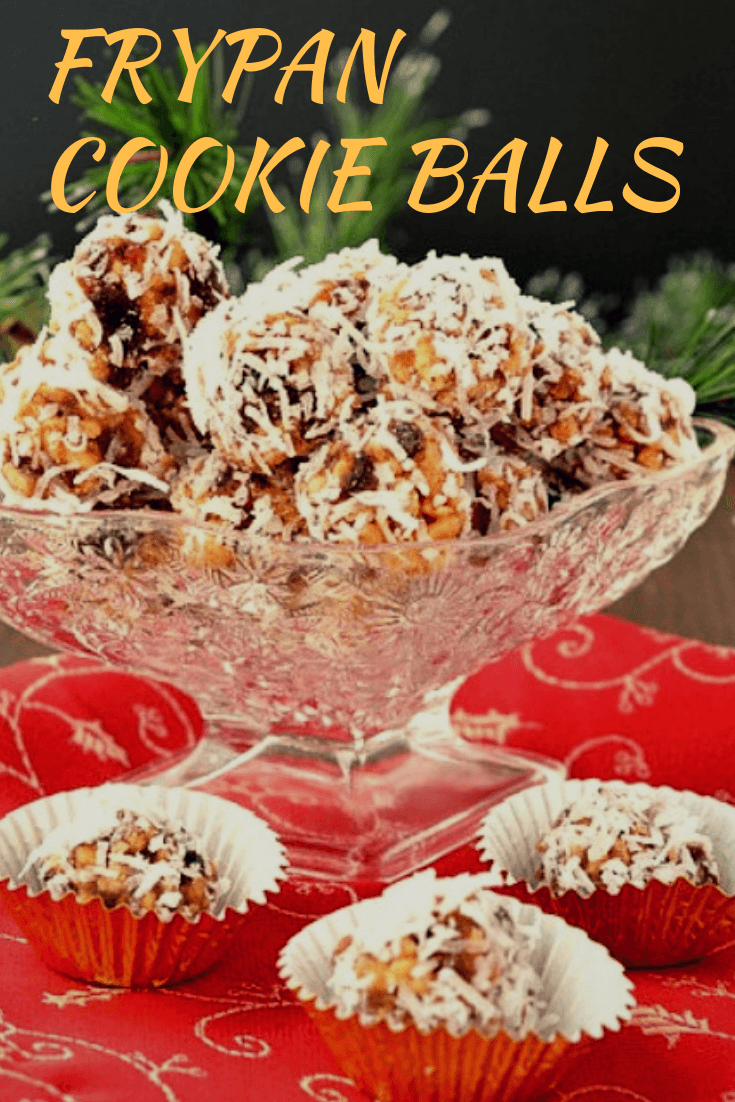

This is one of my all-time favorite cakes! It’s colorful and it’s tasty. While I make this cake at any time of the year (and it’s often a staple in my freezer because it freezes very well), it’s a great Christmas cake because of the colorful gumdrops which give it a festive appearance. It is also a perfect alternative for those who do not like the traditional fruitcakes associated with the holiday season. It’s lighter, both in the color of the cake and its texture, than a fruitcake and yet it is colorful with its myriad of shades of gumdrops.
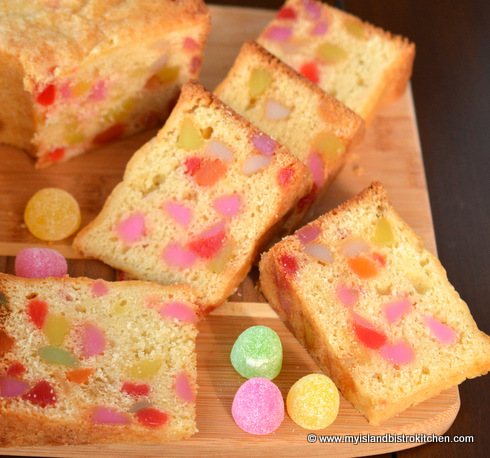
The cake is a bit time-consuming to make because cutting the sticky gumdrops can be a bit tedious and it does take over 2 hours to bake so you do need to do some planning ahead to make this cake. That said, the method is not at all difficult.
To begin, buy good sugared gumdrops. Hard to believe it but there is a difference in the quality of gumdrops. Don’t use black gumdrops in this cake – those are good for snacking while cutting up the other colored gumdrops 😉 Black gumdrops are just plain ugly in a cake and may bleed out their intense color. I also don’t put a lot of white gumdrops in the cake either because they are not bright and showy enough. Cut each of the gumdrops into 3-5 pieces, depending on the size of the gumdrops to begin with.
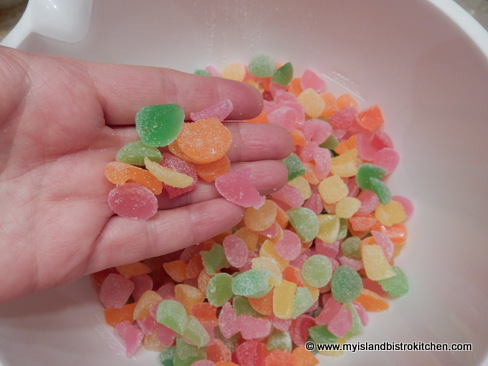 The thing about gumdrops is that they are heavy, even when they are cut. This means there is a possibility they could fall to the bottom of the cake with the top half or more of the cake having few, if any, gumdrops. To counter this issue, make sure the gumdrops are well dredged (floured). Dredging means some of the flour called for in the recipe is used to coat the cut sticky edges of the gumdrops so they don’t all stick to each other and fall, with their collected weight, to the bottom of the cake.
The thing about gumdrops is that they are heavy, even when they are cut. This means there is a possibility they could fall to the bottom of the cake with the top half or more of the cake having few, if any, gumdrops. To counter this issue, make sure the gumdrops are well dredged (floured). Dredging means some of the flour called for in the recipe is used to coat the cut sticky edges of the gumdrops so they don’t all stick to each other and fall, with their collected weight, to the bottom of the cake.
To dredge the gumdrops, simply place the cut gumdrops in a bowl and add a small amount of flour from the amount called for in the recipe. By spoon or by hand, toss the gumdrops in the flour, making sure the cut side of each gumdrop is well floured.
The other tip to avoid ‘falling gumdrops’ is to only use a reasonable amount in the recipe. It’s tempting to add lots and lots more gumdrops; however, those add weight to the cake and they will likely all get together and congregate to have a party at the bottom of the cake. This cake has a light batter so it doesn’t have the power to hold up a lot of heavy gumdrops. I use 1 pound of gumdrops for this cake and find it is sufficient.
Adding the gumdrops to the batter is the last step in making this cake so, when doing so, fold them in gently with a rubber spatula and don’t over-mix. Just fold them in till there is no flour visible. Over-mixing them will remove the flour from their floured edges and may cause the gumdrops to fall to the bottom of the cake. The flour is meant to act as a “barrier” between the sticky gumdrops and the wet batter. As shown in the photograph below, just keep gently rolling the spatula over and under the batter until all the gumdrops are incorporated.
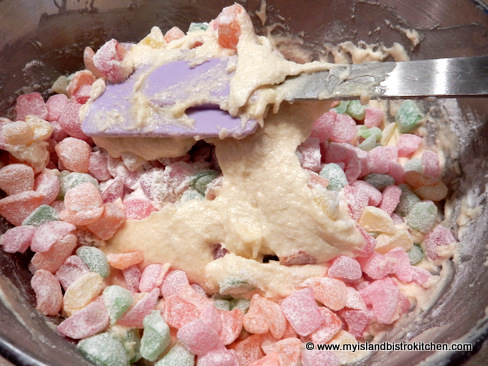
You can see how each roll of the spatula brings up more batter each time until the gumdrops are finally all blended in.
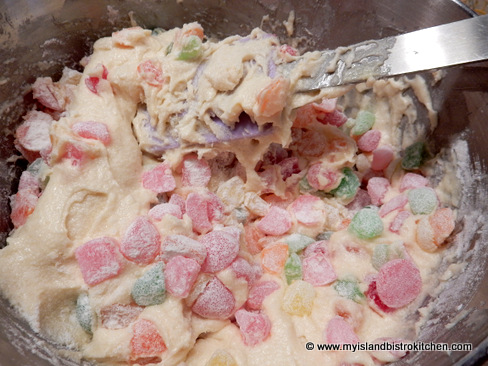 The batter for this cake will not result in a lily-white cake because it uses butter. To get a white cake, shortening would have to be used but you would be sacrificing the butter flavour for which this cake is meant. Use the good stuff!
The batter for this cake will not result in a lily-white cake because it uses butter. To get a white cake, shortening would have to be used but you would be sacrificing the butter flavour for which this cake is meant. Use the good stuff!
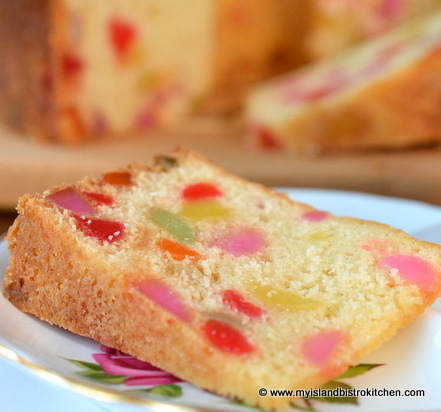
The butter will cream much easier and faster if it is at room temperature so take the butter out of the fridge an hour or two ahead of preparing the cake. Avoid the temptation of softening the butter in the microwave as, inevitably, some of it will melt and that causes a different texture to the butter. I also remove the eggs and the milk from the fridge about 35-40 minutes before making the cake, bringing them to room temperature. I find this helps the ingredients to incorporate better and more smoothly than if they are used in their refrigerated cold state.
The best pan to use for this cake is a funnel cake pan. The hole in the center of this pan helps the cake to bake evenly without it falling in the center, leaving it unbaked and gummy. I use my large 16-cup angel food pan for this recipe but a slightly smaller funnel pan would accommodate the amount of batter called for in this recipe.
Place the oven rack in the center of the oven to bake the cake and place the cake pan in the center of the rack. If the cake starts to brown too quickly on the top, loosely lay a piece of tin foil over the top of the pan once the top of the cake is set. It takes about 2 hours and 15 minutes for this cake to bake in my oven but I recommend that you start testing for doneness at the 2 hour point so the cake does not dry out. It is done when a cake tester inserted near the center close to the funnel comes out clean and the top of the cake is no longer sticky.
Remove the cake from the oven and let it cool in the pan for 20-30 minutes then turn it out on to a wire rack, removing the parchment paper from the bottom of the cake. Let the cake cool completely before cutting. This cake is best left for a day or two to age before slicing it.

Ingredients:
1 cup butter, softened
1⅔ cups granulated sugar
3 eggs, room temperature
1¼ tsp vanilla
1 tsp almond flavouring
1 tsp lemon flavouring
3 cups flour (reserve 1/4 cup for dredging cut gumdrops)
2½ tsp baking powder
½ tsp salt
1 cup milk, room temperature
1 lb gumdrops, cut into 3-5 pieces each
Method:
Place oven rack in center of oven and preheat oven to 300°F. Grease large funnel pan and line bottom with parchment paper.
In medium-sized bowl, dredge the cut gumdrops with 1/4 cup of the flour, making sure that the cut edges of each gumdrop are well floured. Set aside. In separate bowl, sift together the remaining flour, baking powder and salt. Set aside.
In bowl of stand mixer, cream the butter. Gradually add the sugar, beating until well incorporated. Add the eggs, one at a time, beating well after each addition. Beat in the vanilla along with the almond and lemon flavourings. Add the dry and wet ingredients in three parts (3 parts dry and 2 parts wet) starting and ending with the dry ingredients. After all ingredients have been added, beat batter on medium speed for 1 minute.
Remove bowl from stand mixer and, by hand, gently fold in the floured gumdrops just until incorporated and no dry flour remains visible. Do not overmix.
Transfer batter to prepared pan and, with knife, smooth batter out even. Bake for approximately 2¼ hours or until cake tester inserted near funnel center of pan comes out clean. Remove cake from oven and let cool in pan for 20-30 minutes then turn cake out onto wire rack to cool completely. Cake will slice better a day or two after baking.
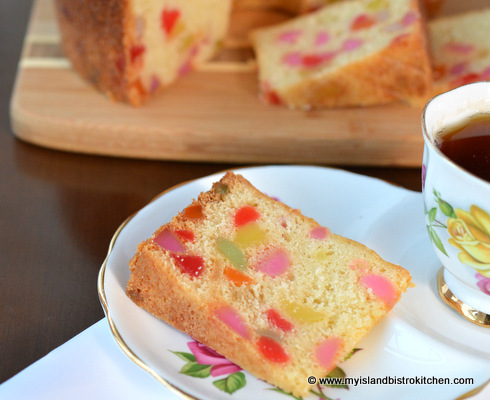
Join the Facebook page for My Island Bistro Kitchen: https://www.facebook.com/MyIslandBistroKitchen/
Follow “the Bistro” on “X” (formerly Twitter): https://twitter.com/PEIBistro/
See the drool-worthy gallery of mouth-watering food photos from My Island Bistro Kitchen on Instagram: https://www.instagram.com/peibistro/
Follow “the Bistro” on Pinterest at https://www.pinterest.ca/peibistro/ and pin the Pinterest-ready photo found at the end of this post to your favorite Pinterest boards.
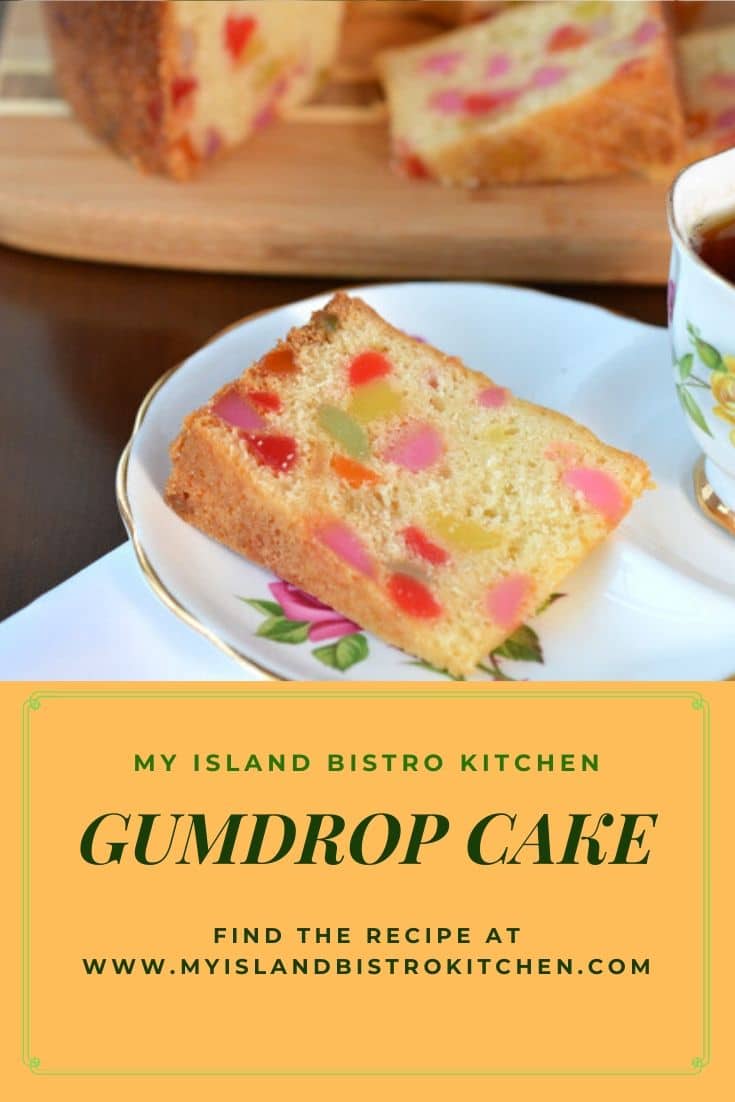
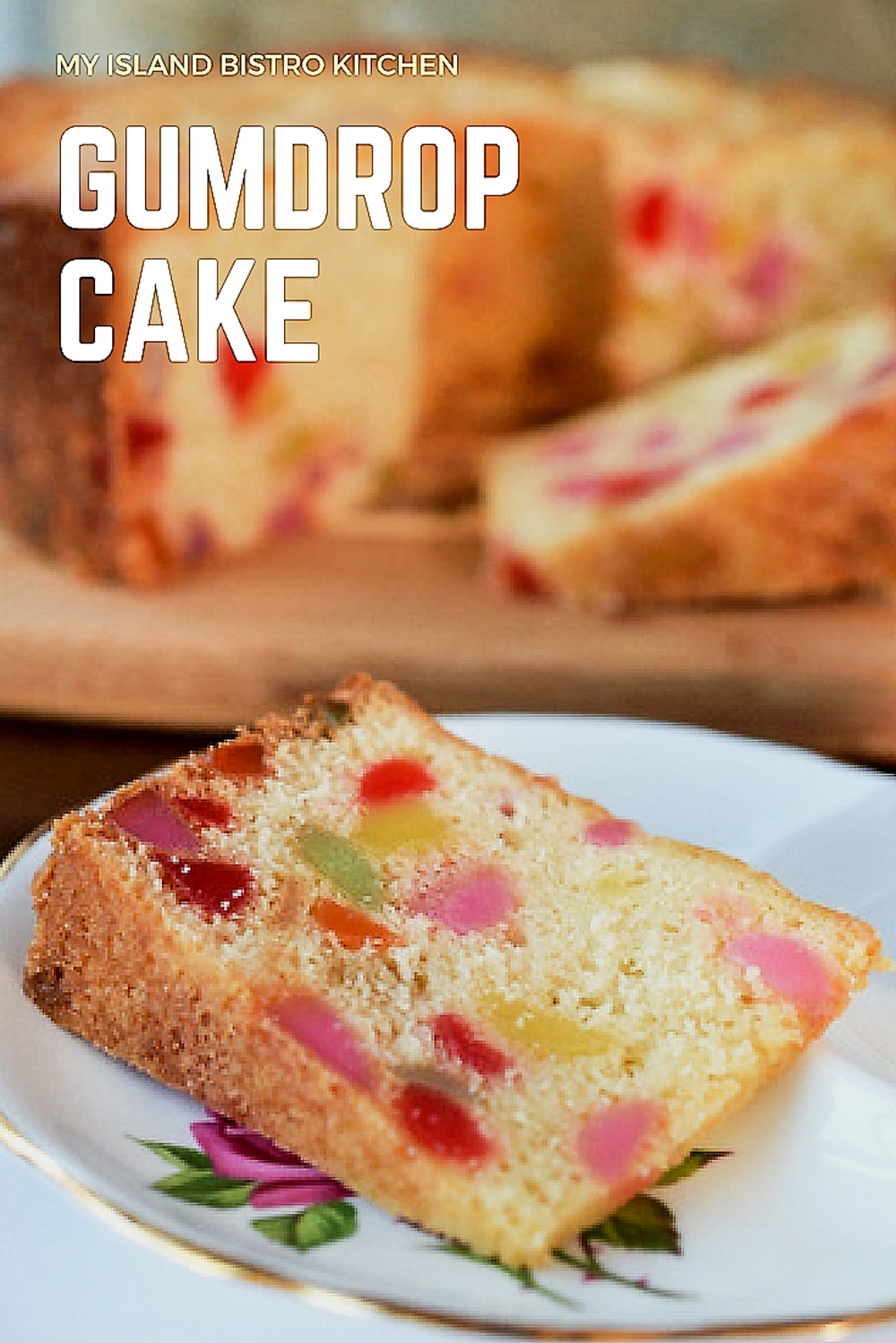
——————————————————————————
A buttery cake loaded with flavour and dotted with colorful gumdrops.
Ingredients
Instructions
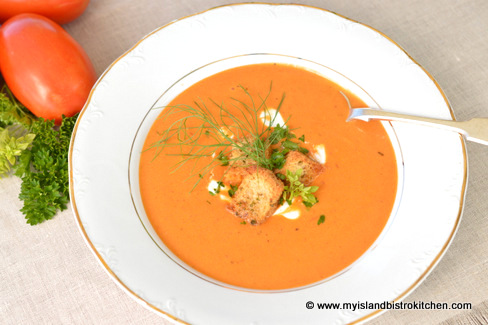
One of my all-time favorite comfort soups is homemade tomato soup. I have been working for the past couple of years to develop a tomato soup recipe that uses the right blend of ingredients and spices to achieve a balanced tomato soup that is pleasing to my palate. Recipe development can be a lengthy and tedious process and the recipe I am sharing today is the result of my efforts. Once I crafted the final version of this soup, no canned tomato soup will now do! Continue reading Cream of Roasted Tomato Soup
Title: Best of Bridge Home Cooking
Author: Various
Publication Date: 2015
Publisher: Robert Rose Inc.
Cover: Hardcover
Price: $29.95
Pages: 360
Robert Rose Inc. has offered me the opportunity to conduct a review of Best of Bridge Home Cooking. This is the latest in the “Best of Bridge” series of cookbooks.
This cookbook is a collection of standard home cooking recipes that aims to get people in to the kitchen to create special memories and meals around the table. Many of the recipes would be suitable for every day meals. The book has an attractive, sturdy hardcover and the pages are spiral bound making it easy for the book to stay open and the pages to lay flat for the recipe being made.
The book features a collection of 250 recipes spread out through 13 chapters: Breakfast, Breads & Muffins; Snacks, Spreads & Dips; Soups; Salads; Sandwiches, Lunches & Light Suppers; One-pot Dinners; Pizza, Pasta & Noodles; Meatless Mains; Fish & Seafood; Chicken & Turkey; Pork, Lamb & Beef; Side Dishes; and Desserts & Sweet Treats. At the beginning of each chapter, there is also a separate table of contents outlining the recipes (and their page numbers) found in that section of the book. There is also a handy alphabetical index at the back of the book.
Each recipe is accompanied by a 1-2 sentence lead-in about the recipe and many offer serving suggestions. In addition, useful tips and suggestions for alternate ingredients or ways to vary a recipe are provided with many of the recipes.
The Best of Bridge books use capital letters in a font that I find too large and folksy. This makes the pages cluttery and difficult to read. Generally, the instructions for making the recipes are all lumped together in one long paragraph, as you’ll see in the three recipes below which the publisher has granted me permission to include with this review. This instruction-writing style makes it difficult to follow the method. I find cookbooks that lay out the instructions in separate, step-by-step paragraphs are easier to follow, particularly for less experienced cooks. Breaking down the steps of a recipe into separate short paragraphs makes them less daunting and it is easier and quicker to find your place and progress in the instructions as you go about making the recipe.
I found the ingredients in recipes are used in the instructions in the order in which they are listed and, for the most part, the instructions are easily understandable. The recipes in the book call for, what I would consider to be, ordinary ingredients which makes it easy to shop for and to prepare the dishes. Most, if not all, ingredients would be found in standard supermarkets. However, many recipes call for pre-packaged foods and, in particular, a lot of canned goods. While this may have been a trend in the 1970s – 1990s, and it is a quick way to pull together a meal, today there is a trend toward the slow food movement, cooking from scratch, and cooking healthy. Therefore, with many diets restricting the amount of salt intake, simply opening and dumping cans of salt-laden ingredients with preservatives into dishes to make a meal may not be a selling point for everyone.
The exact quantity of ingredients called for in some recipes is sometimes vague. For example, some recipes call for ingredients in measures such as 1 head of broccoli, 2 small zucchini, or 1 bunch of asparagus. These products are available in different sizes so it would have been clearer to have specified a certain pound or kilogram measure, for example. As well, some recipes call for 1 onion – onions, too, come in different sizes so, for the benefit of more inexperienced cooks, it would be preferable if the ingredients specified if it is ¼ cup, ½ cup, or 1 cup of chopped onions. Providing exact measures helps to ensure successful cooking, particularly for novice cooks.
I also found several recipes in the book for the same dish – for example, there are about 5 chili recipes and more than one recipe for shepherd’s pie. When I buy a cookbook, I expect that it has been quality controlled and recipes are not repetitive, even if there are slight ingredient differences in the recipes. Therefore, unless the cookbook is specifically a book on chili or shepherd’s pie, I suggest picking just one recipe for each when it is a general cookbook. The other thing I noted was that there were some really basic recipes like the one on page 8 for hot oatmeal calling for rolled oats, salt, and water. If I am paying $29.95 for a cookbook, I am not looking for a recipe that would be available on the back of a rolled oats package when I buy them. Recipes for basic potato salad, peanut butter cookies, macaroni and cheese, and simple stir-fries are ones that can be found in other sources such as existing cookbooks or through a quick internet search. If I am buying a cookbook today to add to my collection, I am looking for one that has new or different recipes that I don’t already have in one or more cookbooks already on my shelf or would not likely be able to find through an internet search. In short, I’m looking for something new and different or, if it is a traditional recipe, that it has been updated or jazzed up in some way.
There are a lot of slow cooker recipes in this cookbook. Not everyone owns a slow cooker, or even likes to cook by that method. My suggestion would be that with a count of about 40 slow cooker recipes in the book, perhaps those should have been reserved for a specialized slow cooker recipe book.
There are 24 color photos in the book and they are of good quality but there is obviously not a photo for each of the 250 recipes. Including photos is so important in a cookbook as, not only do photos of mouth-watering food inspire people to try the recipes but the color photos also give a frame of reference of what the finished dish should look like. Including a large book of page after page of solid print is not very inviting or inspiring, particularly when the subject matter is food.
Test-driving recipes
I tested three recipes out of the cookbook. Robert Rose Inc has given me permission to share the recipes and their photos for Carrot Raisin Muffins, Just Peachy Pork, and Creamy Tuna Pasta Bake to accompany my review of this cookbook. The recipes follow at the end of this review.
Carrot Raisin Muffins
These muffins combine a tasty combination of grated carrots and apple, raisins, coconut, cinnamon, and nutmeg. These turned out for me but they are time-consuming to make because the carrots and apple have to be grated. The recipe indicates that it yields 16 muffins; I got 15 out of the batch and they certainly were not large muffins by any means. The instructions said to bake the muffins for 25-30 minutes; however, mine were baked in 17 minutes (and my oven has true temperature) so the baking time was off substantially.
Just Peachy Pork
This recipe, in a word, was a flop and it had expensive ingredients in it. The recipe calls for 1 lb pork tenderloin, canned peaches, green pepper, barbecue sauce, and Dijon mustard. When I read the recipe, I wondered if it had enough of the right ingredients to give it flavour and I found it did not. This dish had absolutely no flavour and was not a good use of an expensive pork tenderloin. The list of ingredients caused me to wonder what color the sauce would be. The sauce turned an ugly gray-brown color (probably due to the barbeque sauce and mustard) and the green pepper discoloured and went limp as it cooked in the oven. This dish turned out to be a very unappetizing color, did not plate well, and had zero flavour. I will not make this again. The publisher has provided a photograph for the purposes of this review and my dish did not in any way resemble the promotional photograph.
Creamy Tuna Pasta Bake
This recipe turned out fine for me and is quite tasty. It calls for ingredients that actually give a flavour boost to a typical tuna casserole.
Concluding Thoughts
While I can appreciate that the goal of this book may be on using easy-to-find, common ingredients to prepare fast and convenient meals at home, I am not a fan or advocate of using a lot of prepared foods in dishes I cook. I found that there were many recipes in Best of Bridge Home Cooking that use pre-packaged ingredients that come with a lot of salt and preservatives.
There is substantial competition on the cookbook market and through recipes available for free on the internet. While the Best of Bridge Home Cooking does have some tasty recipes, I would have to say, overall, I didn’t find a lot of inspiration or anything really new and creative in the book. In fact, I found most recipes were ones for which I could find equally-good or better/similar ones in other cookbooks or on the internet.
The following three recipes and accompanying photos are courtesy of Best of Bridge Home Cooking by The Best of Bridge © 2015 www.bestofbridge.com Reprinted with permission. Available where books are sold.
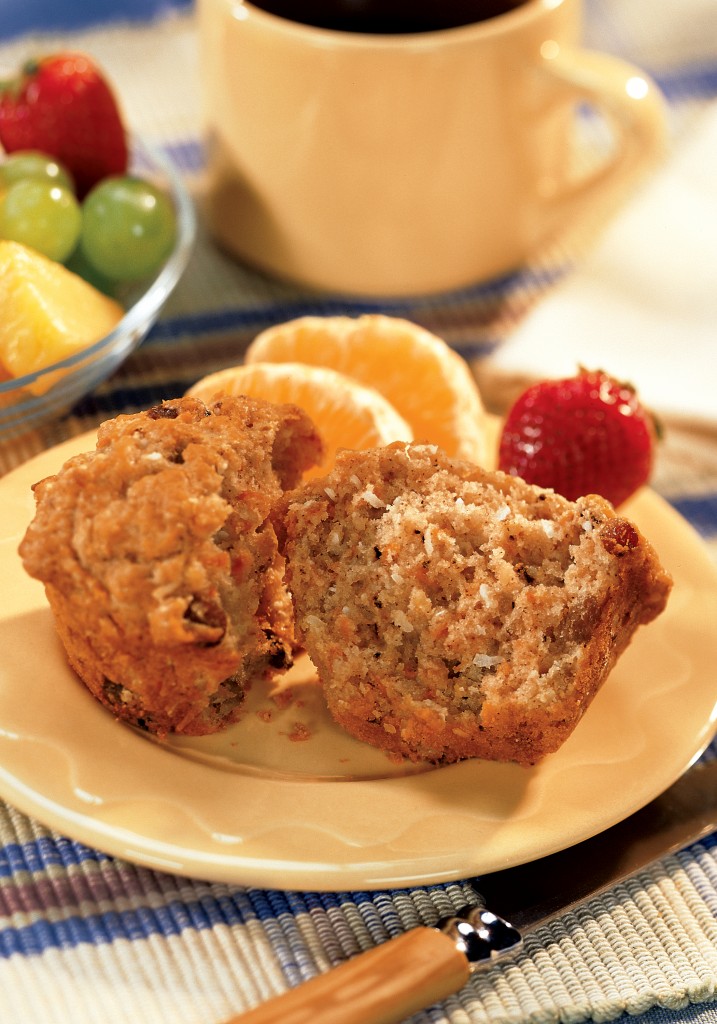
Packed with nuts, fruits and carrots, these scrumptious muffins are perfect for breakfast. But they are just as tasty for afternoon snacks or stowed away in a lunch box.
2 cups all-purpose flour (500 ml)
3⁄4 cup granulated sugar (175 ml)
11⁄2 TSP ground cinnamon (7 ml)
1 TSP baking powder (5 ml)
1 TSP baking soda (5 ml)
1⁄2 TSP freshly grated nutmeg (2 ml)
1⁄4 TSP salt (1 ml)
11⁄2 cups grated carrots (about 3 medium) (375 ml)
1 cup grated peeled apples (250 ml)
1⁄2 cup raisins (125 ml)
1⁄2 cup sweetened shredded coconut (125 ml)
1⁄2 cup chopped walnuts (optional) (125 ml)
2 large eggs (2)
2⁄3 cup plain yogurt (150 ml)
1⁄3 cup vegetable oil (75 ml)
Preheat oven to 375°F (190°C). Grease 8 cups in each of two 12-cup muffin pans or line the cups with paper liners. In a large bowl, stir together flour, sugar, cinnamon, baking powder, baking soda, nutmeg and salt. Stir in carrots, apples, raisins, coconut and walnuts (if using). In another bowl, beat eggs; add yogurt and oil. Stir into flour mixture just until combined. (Batter will be very thick.) Spoon batter into prepared muffin cups, filling almost to the top. Bake for 25 to 30 minutes or until tops spring back when lightly touched. Let cool in pans for 5 minutes, then transfer muffins to a wire rack to cool.
Makes 16 muffins.
Tip: Have only one muffin pan? Place muffin paper liners in 6-oz (175 ml) glass custard cups or small ramekins and fill with extra batter. Bake alongside muffin pan.
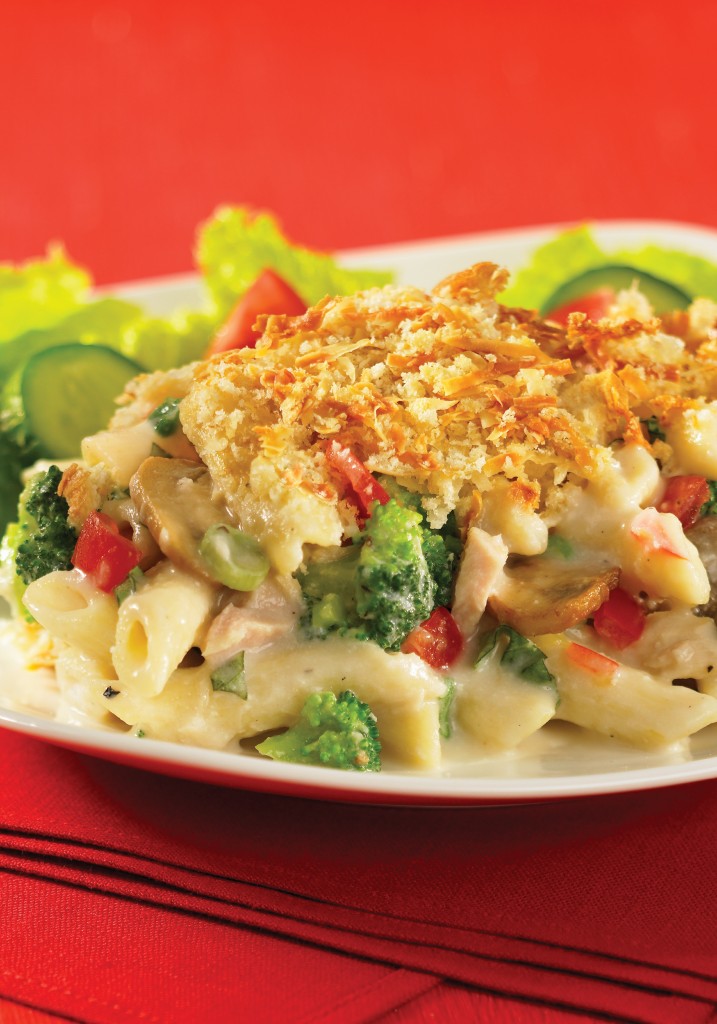
This modern rendition of a tuna casserole includes a nutritional boost of broccoli in a creamy basil sauce.
2 bsp butter (30 ml)
6 green onions, chopped (6)
3 cloves garlic, finely chopped (3)
4 cups sliced mushrooms (1 L)
1⁄2 TSP salt (2 ml)
1⁄2 TSP freshly ground black pepper (2 ml)
1⁄3 cup all-purpose flour (75 ml)
2 cups light (5%) cream or milk (500 ml)
11⁄2 cups Chicken Stock (page 42) or ready-to-use chicken broth (375 ml)
3 tomatoes, seeded and diced (3)
2⁄3 cup freshly grated Parmesan cheese (150 ml)
1⁄2 cup chopped fresh basil (125 ml)
12 oz penne (375 g)
4 cups broccoli florets and chopped peeled stems (1 L)
2 cans (each 6 oz/170 g) solid white tuna, drained and flaked (2)
1 1⁄2 cups soft fresh bread crumbs (375 ml)
1 cup shredded Asiago or mozzarella cheese (250 ml)
Preheat oven to 350°F (180°C). Grease a 13- by 9-inch (33 by 23 cm) baking dish. In a Dutch oven or large saucepan, melt butter over medium-high heat. Cook green onions, garlic, mushrooms, salt and pepper, stirring occasionally, for 5 minutes or until softened. In a bowl, whisk flour with 1⁄2 cup (125 ml) cream until smooth; add the remaining cream. Add to pan along with stock. Bring to a boil, stirring, for 3 minutes or until sauce thickens. Remove from heat. Stir in tomatoes, Parmesan and basil. (Can be prepared to this point, covered and refrigerated for up to 1 day.)
In a large pot of boiling salted water, cook pasta for 7 minutes or until almost tender. Add broccoli; cook for 2 minutes or until broccoli is bright green and crisp, and pasta is just tender. Drain; chill under cold water. Drain well and return to pot. Stir in tuna and sauce. Spread in baking dish. (Casserole can be prepared to this point; cover and refrigerate for up to 4 hours before serving. Increase baking time by 15 minutes.)
In a bowl, combine bread crumbs and Asiago cheese; sprinkle over top. Bake for 40 to 45 minutes or until golden and center is piping hot.
Serves 8.
Tips: If fresh basil is unavailable, substitute 2 TSP (10 ml) dried basil and cook with onions.
Assemble the dish no more than 4 hours ahead to prevent pasta from soaking up the sauce.
Variation: For a vegetarian version, omit tuna and substitute 1 can (19 oz/540 ml) kidney beans, drained and rinsed.
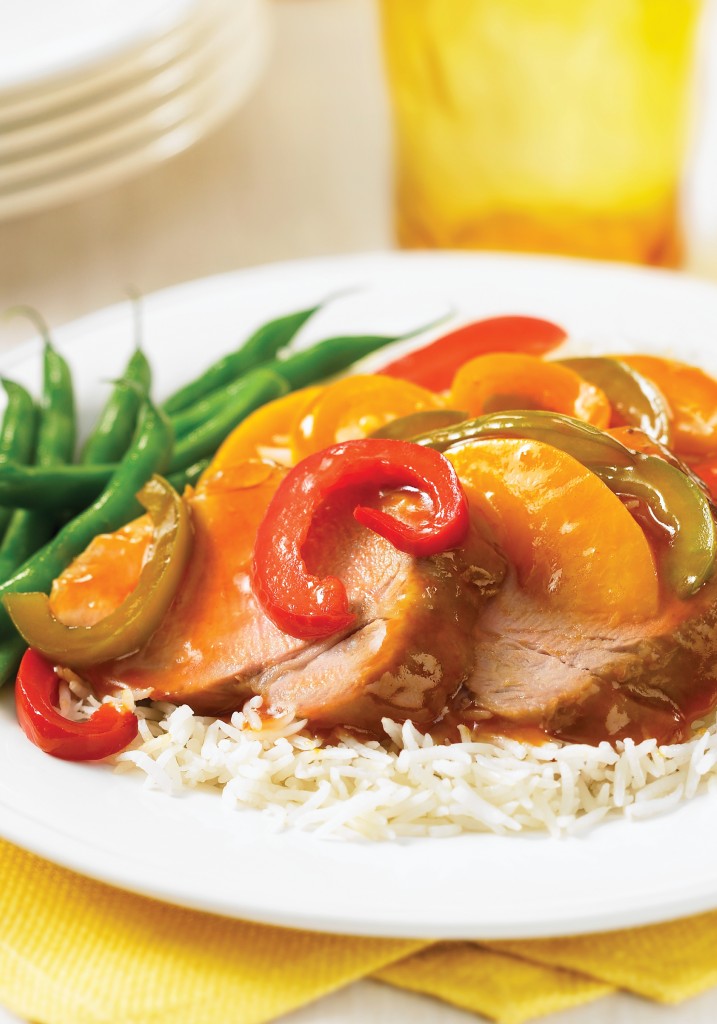
Loaded with peaches, this sweet and tangy sauce is a great accompaniment for pork. Serve over hot white rice and add an assortment of steamed vegetables for a delightfully different meal.
1 can (14 oz/398 mL) sliced peaches, drained, 1⁄4 cup (60 mL) syrup reserved
1 cup finely chopped green bell pepper (250 mL)
(or 1 1⁄2 cups/375 mL
frozen mixed bell pepper strips)
1⁄2 cup barbecue sauce (125 mL)
1 tbsp Dijon mustard (15 mL)
1 lb pork tenderloin, cut into 1⁄2-inch (1 cm) thick slices (500 g)
Preheat oven to 350°F (180°C). In a saucepan over medium heat, combine peaches, reserved syrup, green pepper, barbecue sauce and mustard. Bring to a boil. Reduce heat to low and simmer for 3 minutes. Place pork slices in a single layer in an 8-cup (2 L) baking or gratin dish. Pour sauce over meat. Bake until just a hint of pink remains, about 30 minutes.
Serves 4.
Disclosure: I received a complimentary copy of Best of Bridge Home Cooking from Robert Rose Inc., for the purposes of conducting a review of the cookbook. I received no compensation for this review and was under no obligation to provide a positive review. All opinions expressed are purely my own.
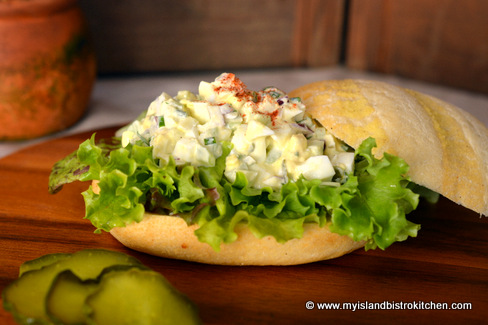
One of my all-time favorite sandwiches is egg salad. It’s also one variety of sandwich that, when I take a plate of sandwiches somewhere, is sure to go first. Continue reading On The Sandwich Board: Egg Salad Sandwich

Homemade salad dressing is simple to make and is a tasty addition to many salads and sandwiches. It’s also a more economical alternative to commercial varieties on the grocery store shelves. Additionally, if you find yourself in need of salad dressing and are not near a supermarket, you can quickly whip up a batch of homemade salad dressing so long as you have eggs, sugar, milk, vinegar, dry mustard, and flour. Continue reading Homemade Salad Dressing